| #2: Van Morrison: "The Philosopher's Stone" (Polydor/Exile, Juni 1998) |
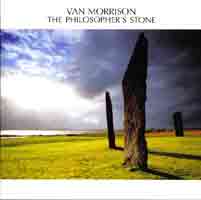 "Nur" eine Outakes-Kompilation und doch besser als vieles,
wofür andere Künstler lange stricken müssten bzw.
das gar nicht hinkriegen würden!
"Nur" eine Outakes-Kompilation und doch besser als vieles,
wofür andere Künstler lange stricken müssten bzw.
das gar nicht hinkriegen würden!

 Mehr ...
Mehr ...
|
Lange hat sich dieser Ausnahmekünstler Zeit
genommen, um seinen Fans einen Einblick in seine Archive zu gönnen.
Nun ist die immer wieder verschobene Doppel-CD-Compilation mit 30 Studioeinspielungen
von 1971 bis `88 endlich erschienen. Und wie von Meister gewohnt, liegt
die Qualität dieser sogenannten „Outtakes“ um einiges über
den regulären Veröffentlichungen der Konkurrenz. Neben einer
Handvoll von Alternativ-Fassungen bereits bekannter Songs („Joyous
Sound“ „Flamingoes Fly“) gibt es Aufnahmen, die damals
möglicherweise aus stilistischen oder einfach zeitlichen (20 Minuten
pro LP-Seite) Gründen weggelassen wurden. Im Kontext dieser Compilation
wirken sie hervorragend, ob es nun Songs sind, die für das Country-eske
„Tupelo Honey“ aufgenommen wurden oder die sage und schreibe
8 Outtakes vom kontemplativen „Hard Nose The Highway“ Album.
„Doppel-LPs sind zur Zeit nicht angesagt“, wird ihm sein A&R
Mann damals erzählt haben.
|
|
| „Was hier an 30 Archiv-Stücken
der Jahre `71 bis `88 auftaucht, hätte anderen für vier reguläre
Alben genügt... R&B, Rock, Soul, Blues und Folk – dank Morrison
beseelt und unverwechselbar verschmolzen.“ (Audio)
|
|
| „Das chronologisch sortierte Repertoire
– und das setzt diesem Projekt die Krone auf – reiht sich Stück
für Stück fugenlos aneinander, zeigt beeindruckend die Entwicklung
des Nordiren zwischen 1971 und 1988. Keine Frage, dieses Ausgrabungs-Monster
könnte glatt als neue Scheibe durchgehen – was Morrison im Keller
hat, werden 10.000 Kollegen ihr Leben lang nicht aus der guten Stube anbieten
können.“ (Rolling Stone. 4 Sterne)
|
|
| #3: Billy Bragg & Wilco: "Mermaid Avenue" (Elektra, Aug. 1998) |
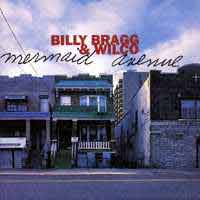 Ein
tolles Projekt: gemeinsam nahmen sich Billy Bragg und Wilco bisher
nicht bekannte Texte von Woody Guthrie vor und schrieben dazu
neue Musik. Die ganze Sache hat den Beteiligten wohl soviel Spaß gemacht,
dass zwei Jahre später noch man ein kompletter Nachschlag erschien! Ein
tolles Projekt: gemeinsam nahmen sich Billy Bragg und Wilco bisher
nicht bekannte Texte von Woody Guthrie vor und schrieben dazu
neue Musik. Die ganze Sache hat den Beteiligten wohl soviel Spaß gemacht,
dass zwei Jahre später noch man ein kompletter Nachschlag erschien!
|
| #4: Son Volt: "Wide Swing Tremolo" (Warner, 1998) |
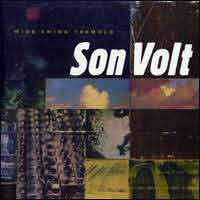 Son Volt, die Band um den Sänger/Gitarristen und Songschreiber
Jay Farrar ist die andere Band neben Jeff Tweedy's Wilco
in der Nachfolge von Uncle Tupelo.
Mich nervt dieser Streit, ob Son Volt oder Wilco die besseren Uncle
Tupelo sind. Dazu nur soviel: beiden Bands merkt man die gemeinsame
Vergangenheit mehrerer ihrer Mitspieler an. Beide Bands haben deshalb
durchaus Ähnlichkeiten im Sound, aber eben auch sehr viel individuelle
Unterschiede. Aber beide Bands sind klasse. Man kann das vielleicht
mit den Produktionen der beiden Ex-Köpfen von meiner Lieblingsband
"The Go-Betweens"
vergleichen: Nur gab's da keinen Fanstreit um den "richtigen"
Erben. Nur eine kurze Theorie von mit dazu: Jay Farrar ist eher Robert
Forster und Jeff Tweedy eher Grant McLennan. Aber wer ist
jetzt Lennon und wer McCartney? Fragen über Fragen!
Son Volt, die Band um den Sänger/Gitarristen und Songschreiber
Jay Farrar ist die andere Band neben Jeff Tweedy's Wilco
in der Nachfolge von Uncle Tupelo.
Mich nervt dieser Streit, ob Son Volt oder Wilco die besseren Uncle
Tupelo sind. Dazu nur soviel: beiden Bands merkt man die gemeinsame
Vergangenheit mehrerer ihrer Mitspieler an. Beide Bands haben deshalb
durchaus Ähnlichkeiten im Sound, aber eben auch sehr viel individuelle
Unterschiede. Aber beide Bands sind klasse. Man kann das vielleicht
mit den Produktionen der beiden Ex-Köpfen von meiner Lieblingsband
"The Go-Betweens"
vergleichen: Nur gab's da keinen Fanstreit um den "richtigen"
Erben. Nur eine kurze Theorie von mit dazu: Jay Farrar ist eher Robert
Forster und Jeff Tweedy eher Grant McLennan. Aber wer ist
jetzt Lennon und wer McCartney? Fragen über Fragen!

 Mehr ...
Mehr ...
|
While Son Volt's first two albums, Trace and Straightaways, received
critical acclaim, they are both very restrained and sparse works underlain
with languidness. These albums hinted, in their best moments, at Son Volt's
potential to both write beautiful songs and rock out, but the band never
seemed to completely let loose and turn it up to 11. Part of this may
stem from their eclectic mix of musical influences. While the juxtaposition
of styles ranging from country to bar-band rock & roll has been the
key to Son Volt's sound, it has also been a point of contention for those
who have criticized them for not knowing what sort of band they wanted
to be. Wide Swing Tremolo represents an attempt to somewhat break the
mold of the earlier releases, especially from the intensely sparse Straightaways.
Wide Swing Tremolo is a wide-open, rocking album with precious little
of the overt country influences found on previous Son Volt works. Instead,
this album is driven by R.E.M.-like arpeggio guitar riffs and muscular,
warm rhythms. It's a strong album.
(by Matthew Hilburn, All
Music Guide)
|
|
| #5: Terry Callier: "Time Peace" (Verve/Talkin' Loud, Mai 1998) |
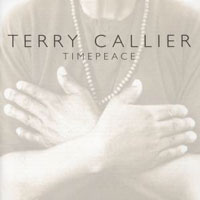 Eine späte Entdeckung! Der Mann ist schon seit den 60ern/70ern
dabei - und ich hatte noch nie was von ihm gehört! Eine tolle
Mischung aus Tim Buckley (diese
akustische 12saitige!) und Curtis
Mayfield (diese Stimme) bzw. aus Folk und Soul. Beim Titelsong
ist sogar Labelkollege und Saxofonmeister Pharoah
Sanders zu hören!
Eine späte Entdeckung! Der Mann ist schon seit den 60ern/70ern
dabei - und ich hatte noch nie was von ihm gehört! Eine tolle
Mischung aus Tim Buckley (diese
akustische 12saitige!) und Curtis
Mayfield (diese Stimme) bzw. aus Folk und Soul. Beim Titelsong
ist sogar Labelkollege und Saxofonmeister Pharoah
Sanders zu hören!

 Mehr ...
Mehr ...
Die späten 90er sind als die "Renaissance des Folk" in
die Popgeschichte eingegangen. Auch wenn man nicht gleich Sampler und
Sequencer in den Müll schmiss, erwachte erneut die Sehnsucht nach
akustischer Einfachheit, die Sehnsucht nach dem guten alten Songformat.
Während die Mehrzahl der Künstler, die dieses Revival vorantrieben,
zur Zeit der originalen Folkbewegung der 60er noch gar nicht auf der Welt
war, landete 1998 auch ein damals relativ übersehener Singer-Songwriter
ein fulminantes Comeback: Terry Callier mit "Timepeace". Als
das Album bei Talkin´ Loud erschien, hatte man 19 Jahre nichts mehr
von ihm gehört. Immer wieder auf Marketing-Kategorien und gegenläufigen
Trends gestrandet, hatte sich Callier 1979 zurückgezogen, um allein
erziehend seine Tochter zu versorgen. Callier machte einen normalen Job
als Computerprogrammierer für die Universität seiner Heimatstadt
Chicago und schien sich komplett vom Musikbusiness verabschiedet zu haben.
Grund zur Verbitterung hatte es allemal für ihn gegeben: Calliers
erste Plattenfirma Prestige verschlief komplett sein Debütalbum.
Als 1968 "The New Folk Sound of Terry Callier" (aufgenommen
1964) endlich erschien, stieß der Meilenstein auf taube Ohren, denn
die Folkbewegung war mittlerweile elektrisch geworden und lief zielstrebig
in Richtung Psychedelia. In den 70er Jahren nahm Callier weitere großartige
Alben für das Cadet-Label auf. Der sanfte Folk-Jazz von "Occasional
Rain" und "What Colour Is Love" sollte die frühe Joan
Armatrading und Gil Scott Heron inspirieren. Auf breiterer Ebene schlug
er zur Zeit seiner Veröffentlichung aber keine großen Wellen,
geschuldet war´s dem Desinteresse seiner eigenen Plattenfirma. Erst
die britische Acid Jazz-Bewegung sollte Callier in den frühen 90ern
zum verdienten Prestige verhelfen. Als in England seine alten Alben erschienen
und Callier in Londons Jazz Café auftrat, machte er sich zum Guru
der "Goatees" (Kinnbartträger).Einige Jahre später
veröffentlichte er "Timepeace" und das Album bewies Calliers
Integrität. Lückenlos knüpfte es an die Ästhetik seiner
epochalen frühen Alben an. Geschmackssichere Arrangements, filigrane
Instrumentierung um seine akustische Gitarre herum, atmosphärische
Sounds und ein fein gewebter Klangteppich zwischen Folk, Soul und Jazz
untermalen Calliers idealistische Prophezeiungen von Love, Peace und positivem
Denken. Gaststar auf dem Titel "Timepeace/No One Has To Tell You/Build
A World Of Love" ist Pharoah Sanders, Weggefährte John Coltranes,
der sein außerirdisches Tenorsaxofon vielleicht noch nie zuvor in
einen so popkompatiblen Kontext einbrachte. Weitere Highlights sind das
epische "Lazarus Man", der leichtfüßige Bossa Nova
"Keep Your Heart Right" und der Country von "Coyote Moon".
Callier covert zwei Soulklassiker auf "Timepeace": Curtis Mayfields
Aufbruchssong "People Get Ready" und interessanterweise auch
"The Love Theme From Spartacus", einen Filmschmachter, der zum
beliebten Jam in Jazzkreisen avancierte. Egal ob in den 60ern, den 90ern
oder auf seinem aktuellen Album "Looking Out" (2004). Kompromisslos
und integer hat Callier seine musikalische Sinnsuche jenseits aller Karriere-Kriterien
verfolgt- nur so wird man zur Kultfigur.
(www.pure.de)
Chicago native Terry Callier has a long career that goes back to a debut
album in 1968. Callier as a child, growing up in the notorious Cabrini-Green
housing project in the Windy City, showed some musical ability and had
several years of piano lessons. But it wasn't until college in the early
1960s, where his dorm room was near a student who owned a guitar, that
Callier took up that instrument and started learning traditional folk
songs, in the days of the Sixties folk "boom." In 1964, he was
spotted in a blues club in Chicago playing his acoustic music by Sam Charters,
then of Prestige Records, who the following year recorded Callier's first
LP, entitled The New Folk Sound of Terry Callier. The record wasn't released
until 1968, when by then his acoustic sound had been replaced in the public
ear by the electric folk-rock of the period.
In 1970, Callier and his songwriting partner Larry Wade began working
with soul star Jerry Butler and his Chicago Songwriter's Workshop. Callier
and Wade wrote several songs which became hits, including The Love We
Had Stayed on My Mind, which was made famous by the Dells in 1972.
After that, Callier began a series of albums under his own name, starting
with Occasional Rain in 1973 and concluding with Turn You to Love in 1979.
His music was a breezy blend of folk influence, including articulate lyrics,
plus soul and jazz. But like many during the period, some of his records
succumed to the disco influence of time. In 1983, he dropped out of the
music business to help raise his family and to begin a new career as a
computer programmer for the University of Chicago, where he also completed
a degree in sociology by taking night classes.
One day in 1991, he received a call from England from some dance remixers
and people on the so-called "acid jazz" scene, who were interested
in releasing his old albums in the UK. He began making pilgrimages to
England to perform, and that eventually led to the revival of his recording
career. Parts of Time Peace were recorded in England.
This sort of folky, jazzy and soul-influenced style was also taken up
occasionally by such people as Richie Havens, Taj Mahal, early Joan Armatrading
and Gil Scott-Heron. On Time Peace, Terry Callier gives us one of the
finest examples of the genre, with tasteful musicianship, an often atmospheric
sound and Callier's outstanding vocals. Lyrically, the album seems a period
piece, with his songs about peace, love and being positive to overcome
adversity, racial or otherwise -- the old-fashioned values of idealism
that have hardly been heard since the last Gil Scott-Heron album.
Joining Callier is a variable group of musicians, mostly from the Chicago
area, with notable cameo appearances by Pat Metheny Group drummer Paul
Wertico and harmonica virtuoso Howard Levy. Also making an appearance
on one track is jazz saxophone great Pharoah Sanders, who worked with
Callier many years ago. Like the concept albums of yore, Callier divides
his CD into two sections, "Time" and "Peace" with
one track serving as an overall introduction. Most of the music consists
of new original material, but he does parts of tunes from the 1960s, Curtis
Mayfield's People Get Ready, and, interestingly, The Love Theme from Spartacus.
Some might be tempted to call Terry Callier's new CD Time Peace a throwback
to the 1960s with its jazzy, soulful sound, and especially its lyrics
that dare to talk about peace and love and hope. But this particular style
never made much of an impact on the commercial music scene of the day,
and after such a long period of inactivity, Callier and his music now
seem fresh and vital today. The musicianship is outstanding, Callier's
vocals are absolutely first-rate and wonderfully memorable. What he sings
about may be considered a relic of the past in the cynical or just-plain-dumb
1990s, but one comes away from the record feeling positive, without the
music reaching the point of being sappy. Callier is a literate lyricist
and first-rate composer, and his music now comes across as having a timeless
aura.
The album's sound quality is also first-rate. The recording was produced
by Brian Bacchus and mixed by James Nichols, who really enhanced the atmospheric
arrangements with their sonic approach. The dynamic range is also very
good.
It has been about 19 years since Terry Callier released his last album.
His fine new CD Time Peace marks a most welcome return. (George Graham).
|
| #6: Victoria Williams: "Musings Of A Creekdripper" (Atlantic, Mai 1998) |
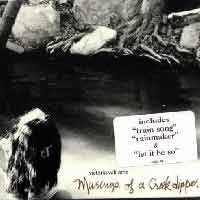 Wunderbar
schaurig-schöner Schrammel-Singer-Songwriter-Folk-Pop-Rock. Es
bleibt allerdings unklar, wie eine Plattenfirma wie Atlantic so etwas
unkommerzielles verkaufen will. Wunderbar
schaurig-schöner Schrammel-Singer-Songwriter-Folk-Pop-Rock. Es
bleibt allerdings unklar, wie eine Plattenfirma wie Atlantic so etwas
unkommerzielles verkaufen will. |
| #7: Motorpsycho: "Trust Us" (Stickman, März 1998) |
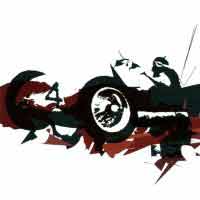 Geniales
Trio aus Norwegen, das alles in dem Bermudadreieck von Heavy Metal,
Freejazz und Countrymusik drauf hat. Und die beste 70er-Jahre-Mucke
in unseren Tagen spielt. In einem wahrlich unbändigen Schaffensdrang
wurden für diese Doppel-CD 14 neue Songs eingespielt, incl. dem
Ohrwurm "Vortex Surfer". Geniales
Trio aus Norwegen, das alles in dem Bermudadreieck von Heavy Metal,
Freejazz und Countrymusik drauf hat. Und die beste 70er-Jahre-Mucke
in unseren Tagen spielt. In einem wahrlich unbändigen Schaffensdrang
wurden für diese Doppel-CD 14 neue Songs eingespielt, incl. dem
Ohrwurm "Vortex Surfer". |
| Sandy Denny: "Gold Dust - Live At The Royality" (Universal/Island, CD: Juni 1998 * Vinyl: Sept. 2022) |
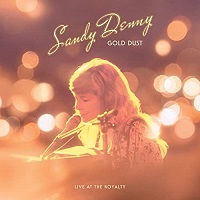 [Fairport Convention: "Liege and Lief" (1969) |
Fotheringay (1970) |
"Sandy" (1972) |
Fairport Convention: "Rising For The Moon" (1975)]
[Fairport Convention: "Liege and Lief" (1969) |
Fotheringay (1970) |
"Sandy" (1972) |
Fairport Convention: "Rising For The Moon" (1975)]

 Mehr ...
Mehr ...
|
Gold Dust: Live at the Royalty captures Sandy Denny's final concert.
The show (performed on Sunday, November 27, 1977) was intended to be the
first date of an 11-city tour, but it turned out to be her last show ever.
It certainly wasn't the way anyone wanted Denny to leave the stage, but
it remains an affecting, surprising farewell. There are familiar items,
to be sure, but the concert also finds her breaking new ground and moving
away from traditional folk-rock to an edgier sound. These are subtle distinctions
that only hardcore fans will notice, but those fans will find Gold Dust
a minor treasure.
(by Stephen Thomas Erlewine , All
Music Guide)
|
|
| #8: Sam Bush: "Howlin' At The Moon" (Sugar Hill, Juli 1998) |
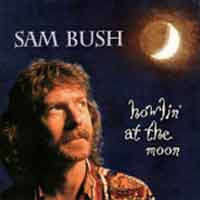 Der
Top-Mandolinist der Szene, Ex-Bandleader von "New
Grass Revival" und Emmylou's "Nash
Ramblers" bietet auf seiner neuen Sugar Hill CD selbstredend
swingende Bluegrass Instrumentals mit unwiderstehlichen Virtuosen
am Arbeitsgerät (Schlagzeuger Larry Atamanuik, die Banjospieler
J.D. Crowe und Bela Fleck, Dobromeister Jerry Douglas,
die Kontrabassisten Victor Krauss und Roy Huskey Jr.,
Bassgitarrist John Cowan, Saitenmulti Darrell Scott).
Auf jedes Instrumental folgt ein hinreißender Vokalsong (tolle
Stimme) wie „Face Tomorrow“, „Hold On“ von Traffic
(!) oder „Song For Roy“, welches dem kürzlich verstorbenen
(und hier noch mitmusizierenden) Akustik-Bassisten Roy Huskey Jr.
gewidmet ist. Da war sich auch Emmylou Harris nicht für
Gesangseinlagen zu schade. Schön unspektakulär und zeitlos
produziert noch dazu. Grassfans werden begeistert sein. Der
Top-Mandolinist der Szene, Ex-Bandleader von "New
Grass Revival" und Emmylou's "Nash
Ramblers" bietet auf seiner neuen Sugar Hill CD selbstredend
swingende Bluegrass Instrumentals mit unwiderstehlichen Virtuosen
am Arbeitsgerät (Schlagzeuger Larry Atamanuik, die Banjospieler
J.D. Crowe und Bela Fleck, Dobromeister Jerry Douglas,
die Kontrabassisten Victor Krauss und Roy Huskey Jr.,
Bassgitarrist John Cowan, Saitenmulti Darrell Scott).
Auf jedes Instrumental folgt ein hinreißender Vokalsong (tolle
Stimme) wie „Face Tomorrow“, „Hold On“ von Traffic
(!) oder „Song For Roy“, welches dem kürzlich verstorbenen
(und hier noch mitmusizierenden) Akustik-Bassisten Roy Huskey Jr.
gewidmet ist. Da war sich auch Emmylou Harris nicht für
Gesangseinlagen zu schade. Schön unspektakulär und zeitlos
produziert noch dazu. Grassfans werden begeistert sein. |
| Bill Frisell: "Gone, Just Like A Train" (Nonesuch, Jan. 1998) |
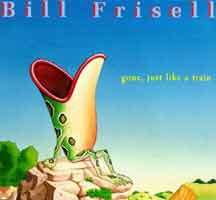 Ein Wahnsinns-Trio: Jazz-Zauberer Frisell zusammen mit dem Bassisten
Victor Krauss (spielt in Nashville alles von Bluegrass, Country
bis Jazz), sowie meinem Lieblingsdrummer Jim Keltner.
Ein Wahnsinns-Trio: Jazz-Zauberer Frisell zusammen mit dem Bassisten
Victor Krauss (spielt in Nashville alles von Bluegrass, Country
bis Jazz), sowie meinem Lieblingsdrummer Jim Keltner.

 Mehr ...
Mehr ...
|
"Bill Frisell is a soulful jazz minimalist with a sophisticated
sense of harmony, a daring rhythmic approach, and an instantly recognizable,
personal sound--part jazz, part rockabilly, part blues, part psychedelia--a
remarkable melodist who can transmute single notes into sapphire tears.
Yet while his fellow improvisors have pursued more and more complex forms,
Frisell seems to be reaching back to the simplest folk forms to animate
his post-modernist's view of Americana, and Gone, Just Like a Train is
a cultural whistle-stop that conveys his land's epic rhythmic dynamism,
regional diversity, and backwaters of mystery and quiet wonder. It's as
if the Modern Jazz Quartet interpolated Cream, and together with his remarkable
collaborators, bassist Viktor Krauss and drummer Jim Keltner, the Bill
Frisell Trio successfully plumbs a variety of expressive forms within
the raging seas of intellectual complexity that have traditionally defined
the domain of modern jazzman." (Chip Stern)
|
|
| "Frisell has a mysterious take on the guitar, one that
can suggest and function in just about any style there is, conjure a wide
range of textures and tones, work in a variety of registers (sometimes at
the same time), and effortlessly slip from inside to outside. With assistance
from bassist Viktor Krauss and drummer to the superstars Jim Keltner (Cooder,
Dylan, Clapton, Harrison), he draws on all of those resources for this follow
up to 1997's Nashville."
(Jazz Times) |
|
| Bob Weir/Rob Wasserman: "Live" (Arista/Grateful Dead, Jan. 1998) |
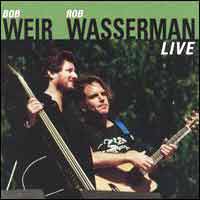 Duo-Liveaufnahmen von 1992 des Grateful Dead-Gitarristen und des aus
seiner Zusammenarbeit mit David Grisman und Lou
Reed bekannten Kontrabassisten. Die Keimzelle der Band Ratdog!
Duo-Liveaufnahmen von 1992 des Grateful Dead-Gitarristen und des aus
seiner Zusammenarbeit mit David Grisman und Lou
Reed bekannten Kontrabassisten. Die Keimzelle der Band Ratdog!

 Mehr ...
Mehr ...
"Two years after the demise of the Grateful Dead, guitarist/singer Bob Weir put a tentative toe in the water of a post-Dead career with this release, his first non-Dead disc since 1984. Part of what made it so tentative was that it was in fact archival material, all but one track coming from the fall of 1988, and that one from the summer of 1992. Weir has been touring with bassist Wasserman since their partnership began with the show recorded for this album, in recent years with extra players under the name Ratdog. Most of the material here is familiar from the Dead's repertoire ("Victim or the Crime," "Throwing Stones") or Weir's ("Looks Like Rain," "Heaven Help the Fool"). But especially when the two break into "Walkin' Blues," the spare acoustic guitar/bass arrangements are liable to remind you not so much of the Dead as of Hot Tuna. Of course, Weir doesn't have Jorma Kaukonen's chops, but he is an enthusiastic singer, and Wasserman remains a wonderfully melodic bass player."
(William Ruhlmann, All Music Guide)
|
| Van Dyke Parks: "Moonlighting: Live at the Ash Grove" (Warner, Feb. 1998) |
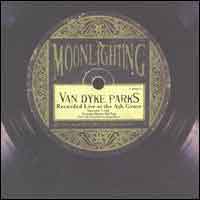 Bereits am 07.09.1996 mitgeschnittener Clubgig des Meisters mit großer Besetzung.
Bereits am 07.09.1996 mitgeschnittener Clubgig des Meisters mit großer Besetzung.

 Mehr ...
Mehr ...
|
"Since Van Dyke Parks has never released a greatest hits album (okay,
he's never had any hits) in the U.S., this long-overdue concert album,
which draws on material from his studio recordings dating back to 1968's
Song Cycle, is a welcome sampler of his stunning, if small, body of work
from "The All Golden" (Song Cycle) to "Orange Crate Art"
(the title track from his duet album with Brian Wilson). The melodic invention
and masterful mixing of styles confirm Parks's hidden status as one of
the great American composers, a status that has gone unremarked only because
of his reclusiveness and tendency to operate only on the margins of the
Los Angeles pop scene. He is a miniaturist, to be sure, and nothing if
not quirky. His heavily — and not always coherently — edited
stage remarks call to mind Truman Capote, and his reedy, earnest singing
is only adequate. But the music is both steeped in tradition and wholly
original, and it's a delight to listen to." (William Ruhlmann, Allmusic)
|
|
| Mark Hollis (Polydor, März 1998) |
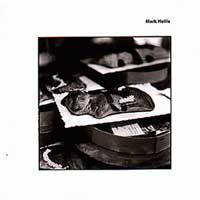 Irgendwann 1997 nahmen der Toningenieur Phill Brown und der
ehemalige Talk Talk Sänger Mark Hollis dieses Album auf,
durchweg mit akustischen Instrumenten. Obwohl die Aufnahmen mit nur
zwei Raummikrophonen gemacht worden sein sollen, dauerte es doch Monate
(und verschlang dabei reichlich Geld) bis man diese beiden Mikros
optimal positioniert hatte. Anfang `98 erschien das Album erstmals,
bekam allerorten richtig viel erstklassige Presse, jeder outete sich
als Talk Talk Fan (oder zumindest der letzten beiden Alben) und das
Album stieg damals sogar relativ hoch in den deutschen LP-Charts ein.
Was einen doch zum Wundern bringt, wenn man dieses sperrige Meisterwerk
erstmals hört.
Irgendwann 1997 nahmen der Toningenieur Phill Brown und der
ehemalige Talk Talk Sänger Mark Hollis dieses Album auf,
durchweg mit akustischen Instrumenten. Obwohl die Aufnahmen mit nur
zwei Raummikrophonen gemacht worden sein sollen, dauerte es doch Monate
(und verschlang dabei reichlich Geld) bis man diese beiden Mikros
optimal positioniert hatte. Anfang `98 erschien das Album erstmals,
bekam allerorten richtig viel erstklassige Presse, jeder outete sich
als Talk Talk Fan (oder zumindest der letzten beiden Alben) und das
Album stieg damals sogar relativ hoch in den deutschen LP-Charts ein.
Was einen doch zum Wundern bringt, wenn man dieses sperrige Meisterwerk
erstmals hört.

 Mehr ...
Mehr ...
|
„...Eine Platte, die die Zeit anhält und die Wahrnehmung verändert.
Nicht von dieser Welt.“ (ME/Sounds)
|
|
|
„... Griffige Melodien sucht man in dieser von Stockhausenschem
Geiste umwehten Minimal Music vergebens, und nur wer darauf verzichten
kann, sollte dieses Pop-Experiment im Selbstversuch riskieren.“ (Stereoplay)
|
|
|
„Schon auf dem letzten Bandalbum "The Laughing
Stock" 1991 war Mark Hollis musikalisch weit entfernt vom Talk Talk-Pop
der frühen Jahre. Die subtilen Streicher- und Bläserarrangement
erinnerten dabei an den genialen Gil Evans, der nicht zuletzt viele Miles
Davis-Platten klanglich geadelt hatte. Als Solist hat sich Hollis nun
noch weiter vom Konventionellen entfernt und kultiviert sein Konzept,
Stille hörbar zu machen. In den sparsam, ausschließlich akustisch
instrumentierten Stücken auf Basis von Piano und Gitarre setzen Mundharmonika,
Trompete, Klarinette und Fagott die Farbtupfer im impressionistisch-anmutenden
minimal jazz sound der langsamen Tempi und melancholischen Stimmungen
des Grüblers Hollis. Skizzenhafter Schönklang als zeitgemäße
Definition einer wohltemperierten Musik.“ (HIFI Test)
|
|
| “Selbst bei Talk Talk war Mark Hollis, dem Bandnamen
zum Trotz, alles andere als ein Plappermaul - und trotz anfangs relativ
flotter Hits wie "It's My Life" alles andere als ein peppiger
Springinsfeld. Solo hält er sich noch mehr zurück - aber äußerst
vornehm. Dafür legt der Londoner wie bei Talk Talk extremen Wert auf
Stimmung und einen klar konturierten Sound. Wer noch das Bild im Kopf hat,
wie der erste Mensch auf dem Mond spazierenging, der mag sich ungefähr
vorstellen können, wie Hollis' Solo-Debüt, sechs Jahre nach der
Auflösung von Talk Talk, klingt: Schwerelosigkeit, Leere, Weite, Faszination.
Das hat mit dem ungeheuer atmosphärischen Raumgefühl zu tun: Hollis
ließ die strikt akustisch eingespielten Aufnahmen nur mit zwei Mikrofonen
(und tadellos) aufs Band bannen. Mit dem elegischen Piano-Einstieg von "The
Color Of Spring" wird der Londoner in diesen närrischen Tagen
sicher keinen Stimmungspokal einheimsen und wohl kaum in den Charts punkten.
Dafür ist sein Stil - hier Ravel'sche Piano-Akkorde oder eine dezent
dissonante Klarinette, da ein jazziger Akustikbaß und pastellene Klänge
von Saiten-Crack Dominic Miller - zu delikat und zu melancholisch. Statt
dessen wird diese CD das Publikum radikal in gelangweilte Verweigerer und
euphorische Befürworter polarisieren. Aber gewiß wird jeder,
der einmal Feuer gefangen hat, von dieser musikalischen Droge kaum mehr
loskommen. Dreht Hollis - für seine Verhältnisse - auf, stoßen
einfach ein paar Instrumente mehr hinzu; steinerweichende oder bluesige
Harmonika-Firnis. Perkusssion, so filligran-fragil, daß man meint,
gleich zerbröseln die Becken. Oder eine Trompete, so "blue"
und intensiv wie das brennende Herzschmerzgefühl im Morgengrauen allein
in einer Bar, nachdem die Freundin oder der Freund sich endgültig verabschiedet
haben. Diese Platte wirkt, als würde sie mehr Luft zum Atmen bieten
als Töne zwischendrin, weil Hollis meint, daß es "besser
ist, eine Note gut zu spielen als zehn schlecht" - darin, in der Tat,
liegt sein Kunstkniff. Seine Musik, seine intensive Stimme wie ein Tim Buckley
in Zeitlupe, entfalten ihre Kraft und Schönheit langsam, aber gewaltig.“
(Audio) |
|
| Calexico: "The Black Light" (City Slang/Quaterstick, Mai 1998) |
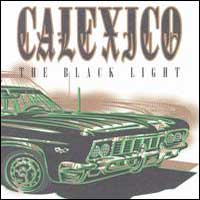

 Mehr ...
Mehr ...
Deeper and richer than their debut, Spoke, Calexico's second album expands upon the sun-baked, cinematic sound of before with the addition of Latin jazz rhythms, mariachi trumpets, and pedal steel; in and of themselves, the group's songs are not exactly compelling, but they're produced with such a fine sense of texture and atmosphere that The Black Light still makes for intriguing listening.
(by Jason Ankeny , All Music Guide)
|
| Guy Chadwick: "Lazy, Soft & Low" (Sony/Setanta, Mai 1998) |
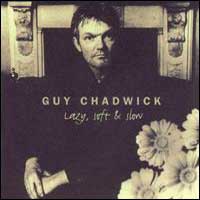 Dass sich das Solodebüt des ehemaligen Chefs vom "The
House Of Love" nicht grundsätzlich von einer Platte
seiner alten Band unterscheidet, hat sicherlich damit zu tun, dass
er ja auch da schon der "Chef" war. Angeblich ist er ein
schwieriger Mensch, was ich seit dem Konzert der wiedervereinigten
Band auf dem Haldern Open-Air 2005 gut nachvollziehen kann.
Ich sag nur: Van Morrison!.
Dass sich das Solodebüt des ehemaligen Chefs vom "The
House Of Love" nicht grundsätzlich von einer Platte
seiner alten Band unterscheidet, hat sicherlich damit zu tun, dass
er ja auch da schon der "Chef" war. Angeblich ist er ein
schwieriger Mensch, was ich seit dem Konzert der wiedervereinigten
Band auf dem Haldern Open-Air 2005 gut nachvollziehen kann.
Ich sag nur: Van Morrison!.
Die Instrumentierung ist etwas offener (mehr Akustikgitarren, mehr
Keyboards, sogar Akkordeon, Geige und Pedal Steel), es "rockt"
weniger. Zwar gibt es keine "offensichtlichen Hits" wie
"Shine On" oder "Christine", aber viele der Lieder
hätten auch auf ein "House
Of Love"-Album gepasst. Nennen wir das Ganze mal etwas marktschreierisch
"Singer/Songwriter-Britpop". Oder besser nicht?
Insgesamt eine sehr schöne Platte - und lange nicht mehr gehört.
Damals nach dem teuren Kauf (34,95 DM!) war sie sehr schnell im Plattenregal
verschwunden und jetzt, nach dem tollen Comeback-Album "Days
Run Away" und dem "interessanten" Haldern-Auftritt
mit Gefühlen zwischen Gänsehaut (bei "Shine On",
"Beatles And The Stones" und dem neuen Lied "Gotta
Be This Way") und Kopfschütteln (über die [fehlende]
Bühnenshow des Sängers), habe ich sie natürlich mal
wieder rausgekramt.
(06.08.2005)

 Mehr ...
Mehr ...
|
How often has a songwriter emerged from a bout of severe writer's block
with such remarkable beauty? Former House of Love frontman Guy Chadwick
has done just that in this low-key debut -- a gorgeous and seemingly effortless
collection of breezy love songs. Many of the tracks would have fit well
on any House of Love record; the only differences are the dashes of accordian,
keyboards, and pedal steel tastefully added to Chadwick's songs, and the
lack of rock guitar. Robin Guthrie's warm production serves these gentle
songs wonderfully, and Guy's backing musicians complement him masterfully
(Guthrie also played bass on eight songs). Lazy, Soft and Slow breaks
no new ground, and nothing here tops such House of Love greats as "Shine
On" or "Christine," but that couldn't have been Chadwick's
intent. If you adore the Harvest-mode Neil Young or favor the "Pale
Blue Eyes" side of the Velvet Underground, this album should warm
your soul for many Sunday mornings to come.
(by Andy Kellman, All
Music Guide)
|
|
| Jim Lauderdale: "Whisper" (BNA, Mai 1998) |
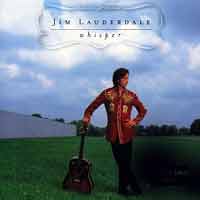 Singende
Songschreiberinnen der Extraklasse mit der Homebase Nashville gibt's
ja inzwischen eine ganze Reihe. Bei den Herren ragt für mich
im Moment ganz klar Jim Lauderdale heraus, Autor von einem meiner
Lieblingslieder Nashville's aus jüngster Zeit: "What Do
You Say To That", das George Strait zu Hitehren brachte
und sich jetzt auch im Waiting For Louise-Repertoire
befindet. Singende
Songschreiberinnen der Extraklasse mit der Homebase Nashville gibt's
ja inzwischen eine ganze Reihe. Bei den Herren ragt für mich
im Moment ganz klar Jim Lauderdale heraus, Autor von einem meiner
Lieblingslieder Nashville's aus jüngster Zeit: "What Do
You Say To That", das George Strait zu Hitehren brachte
und sich jetzt auch im Waiting For Louise-Repertoire
befindet. |
| Gillian Welch: "Hell Amongst Yearlings" (Almo, Juli 1998) |
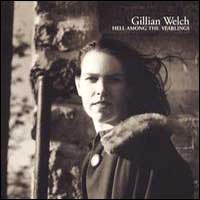 Bereits das zweite Meisterwerk dieses phantastischen Duos (Gitarrist
David Rawlings ist mehr als ein einfacher Begleiter!), das klingt,
als käme es direkt aus den 30er Jahren, aber ohne die geringste
Spur von Nostalgie!
Bereits das zweite Meisterwerk dieses phantastischen Duos (Gitarrist
David Rawlings ist mehr als ein einfacher Begleiter!), das klingt,
als käme es direkt aus den 30er Jahren, aber ohne die geringste
Spur von Nostalgie!

 Mehr ...
Mehr ...
|
Lacking some of the focus that made her debut album so stunning, Hell
Among the Yearlings is nevertheless a thoroughly satisfying second album
from Gillian Welch. Instead of backing away from the rustic folkiness
of Revival, Welch deepens her bleak, clear-eyed worldview, which makes
her spare, old-timey arrangements all the more powerful. On occasion,
the performances and songs are a bit too studied to be truly effective,
but those moments are fleeting -- Hell Among the Yearlings offers ample
proof that Welch is a talented, individual songwriter and that her debut
was no fluke. (by Thom Owens, AMG)
|
|
| Neil Finn: "Try Whistling This" (EMI/Parlophone, Aug. 1998) |
|
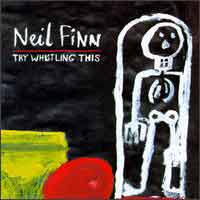 Solo-Debüt
des ex-Chefs von Crowded House. Solo-Debüt
des ex-Chefs von Crowded House.
„Mitpfeifen kann man die wenigsten Melodien,
dennoch wirken sie seltsam eingängig. Finns Alleingang ist
am ehesten als edler Pop mit verhalten rockigen Elementen einzustufen
– oder einfach nur herrlich zu genießen.“ (Audio)
|
| Pharoah Sanders: "Save The Children" (Verve, Aug. 1998) |
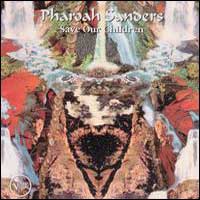 |
| Belle & Sebastian: "The Boy With The Arab Strap" (Jeepster, Sept. 1998) |
 Das zweite Album von der mittlerweile zum Oktett angewachsenen Band
aus Glasgow. Wunderschön melodisch-dichte Songs mit hingehaucht-zartem,
vielfach mehrstimmigen Gesang.
Das zweite Album von der mittlerweile zum Oktett angewachsenen Band
aus Glasgow. Wunderschön melodisch-dichte Songs mit hingehaucht-zartem,
vielfach mehrstimmigen Gesang.

 Mehr ...
Mehr ...
|
“Belle & Sebastian's third album reveals the Glasgow,
Scotland band's recent growth without losing any of the magic of 1997's
acclaimed If You're Feeling Sinister. Frontman Stuart Murdoch is helped
by greater songwriting and vocal contributions from his seven bandmates.
The album builds on the band's gentle blend of orchestral pop (keyboards,
horns and strings) and acoustic folk while incorporating more dynamic
elements, including whispered vocals and cacophonous horns and drums.”
(CMJ)
|
|
| “Unashamedly folk, their songs are as fractured as
Nick Drake's and as lyrically sharp as anything that ever came from Morrissey's
nib, while singer Stuart Murdoch has a voice that is pitched halfway between
Donovan and a church mouse. As with previous outings, this record is all
aural eggshells and emotional hesitancy, demanding a certain patience from
the listener. And although there's nothing to match the sheer ebullience
of earlier single Lazy Line Painter Jane, there's still ample evidence here
to suggest they're capable producing a classic before very long.” (Q.
4/5) |
|
| Dr. John: "Anutha Zone" (EMI/Parlophone, Sept. 1998) |
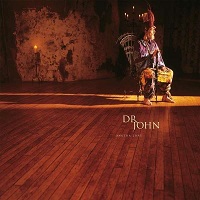 Ein überraschend gutes, stimmiges und mutiges Album des Mannes aus New Orleans, der es nach furiosem
Karrierebeginn in den 60ern und 70ern mit funkig-schrägem Voodoo-Rock in den späteren Jahren
doch etwas gediegener angehen ließ. Das Album entstand teilweise in England mit erklärten Fans des
Meisters, zum Bleistift Paul Weller und Jason Pierce
von Spiritualized, die ihn offensichtlich zu Höchstleistungen
antreiben konnten ...
Ein überraschend gutes, stimmiges und mutiges Album des Mannes aus New Orleans, der es nach furiosem
Karrierebeginn in den 60ern und 70ern mit funkig-schrägem Voodoo-Rock in den späteren Jahren
doch etwas gediegener angehen ließ. Das Album entstand teilweise in England mit erklärten Fans des
Meisters, zum Bleistift Paul Weller und Jason Pierce
von Spiritualized, die ihn offensichtlich zu Höchstleistungen
antreiben konnten ...

 Mehr ...
Mehr ...
Für diejenigen, die sich die Tage wieder herbeisehnen als Dr. John sich geschminkt hat, unmöglich große Perücken trug und über Gris-Gris, Gumbo Ya-Ya und Lieder wie »Croker Courtbullion« sang, ist »Anutha Zone« tatsächlich eine herzerfrischende Entwicklung.
In den späten 60er Jahren war Dr. John ein visionärer Alchemist, als er mit psychedelischer Symbolik und funkigen Rhythmen arbeitete und sich eine große Fanbase beim Rockpublikum erspielte, um sie dann an gruselige Sumpfmythologien und rauen Southern R&B heranzuführen.
Auf »Anutha Zone« versucht sich Dr. John wieder einmal an diesen düsteren Klängen – mit atemberaubenden Ergebnissen. Songs wie »John Gris«, »Party Hellfire« oder »Soulful Warrior« vermischen langsam schwelende Grooves, intelligentes musikalisches Handwerk und Dr. Johns elegant ruppigen Gesang auf eine brillante Art und Weise und beschwören Bilder düsterer Feierlichkeiten in den Hinterhöfen französischer Viertel.
Dieses Album stellte 1998 zweifelsfrei sein Comeback dar. Die Neuveröffentlichung über Music On Vinyl beinhaltet zusätzlich einen Einleger mit einem wunderschönen Bild des mystischen Dr. John sowie den Credits.
Ohne allen Voodoo sind die Pressungen tadellos, der Sound prall und die Cover ordentlich reproduziert.
(Good Times, Dezember 2016 / Januar 2017)
Dr. John has spent so much time turning out perfectly enjoyable but interchangeable records that it may be easy to forget the spooky voodoo vibes of his earliest, arguably best, records. He may have forgotten it himself, too, but there was a whole generation of British musicians, from Modfather Paul Weller to Spaceman Jason Pierce to the teenaged punks in Supergrass, who remembered the haunted vibe lurking in Gumbo and Gris-Gris. Citing his name in interviews, covering his songs, and enlisting him as a session musician (Mr. Rebennack played on Spiritualized's acclaimed 1997 album, Ladies and Gentlemen, We Are Floating in Space), they created a buzz around Dr. John and were more than willing to play on Anutha Zone, hopefully generating some sales for him in return. As should be expected from any project that is a marketer's dream, the collaborations occasionally seem awkward, but what is surprising is how often it works. Pierce helps Rebennack conjure the psychedelic R&B of his earlier albums, while Weller and Supergrass help keep things cooking; furthermore, members of Primal Scream and Portishead help make "Sweet Home New Orleans" a titanic workout. The Brits aren't as funky as the classic New Orleans musicians, but they are willing to push Dr. John into his best work in years. Anutha Zone isn't a perfect album by any means, but it's Rebennack's most ambitious and rewarding album in many a year.
(by Stephen Thomas Erlewine, All Music Guide)
|
| Vic Chesnutt: "The Salesman And Bernadette" (PLR, Sept. 1998) |
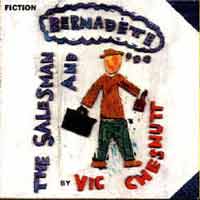 Waren seine bisherigen Platten sehr spartanisch instrumentiert, so
hat er sich hier mit Kurt Wagners Nashville-Orchester Lambchop
zusammengetan.
Waren seine bisherigen Platten sehr spartanisch instrumentiert, so
hat er sich hier mit Kurt Wagners Nashville-Orchester Lambchop
zusammengetan. |
| Mercury Rev: "Deserter´s Song" (V2, Sept. 1998) |
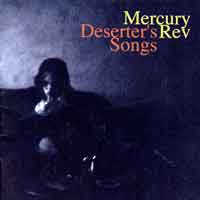 Beeindruckend. Klassischer amerikanischer 60er-Rock trifft auf Spacegitarren
Pink Floyd´scher Schule. Als Gäste dabei Levon Helm
und Garth Hudson von The Band,
schließlich ist es von Kingston, dem Heimatort der Band, nach
Woodstock, wo Levon wohnt, nur ein Steinwurf. Der Albumtitel, der
stammt von einem Greil Marcus Text über die ersten The
Band-Alben.
Beeindruckend. Klassischer amerikanischer 60er-Rock trifft auf Spacegitarren
Pink Floyd´scher Schule. Als Gäste dabei Levon Helm
und Garth Hudson von The Band,
schließlich ist es von Kingston, dem Heimatort der Band, nach
Woodstock, wo Levon wohnt, nur ein Steinwurf. Der Albumtitel, der
stammt von einem Greil Marcus Text über die ersten The
Band-Alben.

 Mehr ...
Mehr ...
...like those early Band albums, `Deserter´s Songs´ is a beautiful, timeless record that draws on decades of influences, yet skilfully distills them into a unique, self-contained work that owes no artistic debts at all.
(Mojo)
|
| Elvis Costello & Burt Bacharach: "Painted From Memory" (Mercury, Sept. 1998) |
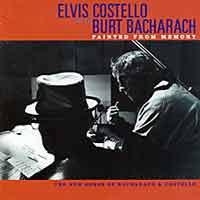

 Mehr ...
Mehr ...
|
"When I do something like this - outside the
normal parameters of rock and roll - it's usually on my own terms, within
my capabilities. I'm not frustrated with the limitations of rock and roll,
or anything like that. It's just that there are different strengths to
this music. It's not better than rock or soul or whatever; it just isn't
those things. I'm not asking everybody to come along for the ride, but
it would be nice if they listened with an open mind." (E.Costello)
|
|
|
"Painted From Memory is likely the most prominent
project Burt Bacharach has done in recent years. Teaming with former punk
rocker and angry young man Elvis Costello, Bacharach has proven to be
revitalized by his new writing partner. And this is an unlikely pairing,
if you think about it. Burt Bacharach has composed numerous movie scores,
recorded his own instrumental albums, and served as musical director and
pianist for a few different singers, Dionne Warwick and Jackie De Shannon
being the most recognizable and most successful of his career. In those
days, Bacharach's writing partner was Hal David.
As writing partners, Costello and Bacharach are an excellent
pairing, unlikely as it seems. It's still evident that Burt contributed
quite a bit to the melodies, and yet there's an updated modern 90's touch
thanks to Elvis's input. These songs could be considered New Pop Classics,
to coin a phrase. I can easily imagine earlier Bacharach collaborators
like Warwick or De Shannon covering these same songs. Highlights here
include the instant classic "Toledo," the after-midnight mood
of "My Thief," the pensive "I Still Have That Other Girl,"
and the longing title track.
I don't guarantee that everyone will like this recording.
If you're no fan of Bacharach, or can't stomach the idea of a rocker doing
pop songs, you would not like this album. I like it because it's different.
Elvis Costello, lyrical collaborator and vocalist of these New Pop Classics,
complements and contrasts with Burt Bacharach in all the right ways. The
lyrics have meat, as do the unobtrusive arrangements. I'll be playing
this one for quite a while...and if others give it the same open-minded
approach, they may enjoy it just as much. Recommended!" (52nd Street
Jazz)
|
|
| Jerry Douglas: "Restless On The Farm" (Sugar Hill, Sept. 1998) |
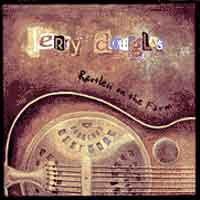

 Mehr ...
Mehr ...
Steve Earle ist die richtige Besetzung für eine fast desperate Version von Johnny Cash´s `Don´t Take Your Guns To Town´, Maura O´Connell macht erwartungsgemäß alles richtig mit Paul Brady´s `Follow On´. Dennoch bleibt das Album eher eine Angelegenheit für Instrumentalfreaks, die gern hören, was sich jenseits stilischer Schranken, zwischen Swing, Bluegrass und Blues, aus Dobro, Lap Steel und Weissenborn rausholen läßt. Douglas wird sie, unterstützt von Sonny Landreth, kaum enttäuschen.
(Rolling Stone. 3 Sterne)
|
| Fit & Limo: "The Serpent Unrolled" (September Gurls, Sept. 1998) |
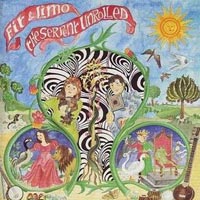 Fit & Limo sind (waren?) ein Duo aus Nürnberg, die
schon "Freakfolk" gemacht hat, als es so etwas noch gar
nicht gab - auf jeden Fall hieß es in den 90ern (noch) nicht
so. Aber eigentlich gibt es so was schon viel länger: denkt doch
mal an die wunderbare Incredible
Sring Band aus den späten 60ern, von denen die beiden ja
schon vier Lieder auf der 7"-EP "This Moment" gecovert
haben. Oder an unser heimisches Duo Witthüser
& Westrupp aus den 70ern.
Fit & Limo sind (waren?) ein Duo aus Nürnberg, die
schon "Freakfolk" gemacht hat, als es so etwas noch gar
nicht gab - auf jeden Fall hieß es in den 90ern (noch) nicht
so. Aber eigentlich gibt es so was schon viel länger: denkt doch
mal an die wunderbare Incredible
Sring Band aus den späten 60ern, von denen die beiden ja
schon vier Lieder auf der 7"-EP "This Moment" gecovert
haben. Oder an unser heimisches Duo Witthüser
& Westrupp aus den 70ern.
Limo kennt vielleicht noch der eine oder andere von Euch noch
als Sänger und Gitarristen der Shiny
Gnomes, Mrs. Fit ist seine Partnerin im Leben und bei der
Musik. Neben Songs von Limo, gelegentlich mit Texten seiner Frau,
gibt es auch zwei äußerst geschmackvolle Coverversionen
zu hören: einmal "Dark Star" von den Grateful
Dead, dargeboten mit Sitar, Bongos und Blockflöte, sowie
"Images Of April", komponiert von Tom Rapp und im
Original zu finden auf dem legendären Album "Balaklava"
seiner Band Pears Before Swine.
Ich fand die LP vor wenigen Tagen für einen erschwinglichen Preis
im 2nd-hand-Laden und stelle fest, dass ich das Exemplar Nummer 106
von 400 gepressten einer limitierten und ansonsten vergriffenen Vinylauflage
ergattert habe. Viel wichtiger ist aber, dass es sich um wunderschöne
Musik handelt.
(07.06.2010)

 Mehr ...
Mehr ...
Fit & Limo stammen aus der bayerischen Provinz. "The serpent unrolled" ist jedoch g�nzlich von Provinzialit�t befreit. Ihr Verst�ndnis von mystischen, weltumspannenden Folk weist sie als Soundalchimisten aus, die als Ausdruck ihrer Schr�gsicht der Welt, sich einfach treiben lie�en. Ihr psychedelisch angehauchter Acid Folk, hat viel 60's Feeling. Ruhig, flie�end, einlullend, sind die vierzehn Titel (u.a. zwei Coverversionen: "Images of April" von Tom Rapp und der all-time Klassiker "Dark star" von Grateful Dead) wie ein entspannter Trip, auf emotionale Ausbr�che wartet man aber vergebens. Die inhaltliche Gelassenheit, kommt durch die vielen akustischen Instrumente zustande, die eine geh�rige Portion Ruhe ausstrahlen. Indische Einfl�sse, britischer und amerikanischer Folk, verschiedenartige Kl�nge, all dies zusammen bildet eine homogene Einheit, bei der aber irgendwie aufgrund der allumspannenden Tr�gheit einfach der letzte Funken nicht �berspringen will. �brigens: neben der CD gibt es �brigens auch eine auf 400 Kopien limitierte LP.
(Kristian Selm, � Progressive Newsletter 1998)
With apologies to the sons and daughters of La Monte Young, I reckon that linearity will only get you so far. The practitioners of acid-folk tend to draw wiggly lines off into mysterious woods, and I thought I�d follow a few to see where they lead. Fit&Limo are an acoustic duo from Bavaria comprising Stefan Limo Lienemann (previously in the Shiny Gnomes) and his female compatriot, who is known to the world only as Mrs. Fit. Ill-advised monikers aside, The Serpent Unrolled is their first full-length release since Autre Monde in 1995, and it was worth the wait. In fact if you have that previous outing, the serpent is probably already unrolling around your turntable or inside your disc player and your are consequently probably in some far off place and not reading this at all. You always hear folks bemoaning the lack of current music that can stand up in the company of visionary works by The Incredible String Band, Pearls Before Swine, Third Ear Band, COB, Caedmon, Mellow Candle and the like. Fit&Limo create acid folk masterpieces that set the controls for the heart of the genre and end up with it glowing in their hands. The 14 tracks are a riot of pan-psychedelic instrumentation with Fit doing mostly keys and percussion duty (glockenspiel, autoharp, harmonium, metallophone, xylophone, toy piano and many more) and Limo doing the string-driven stuff (guitar, sitar, mandolin and so on). Plenty of swapping around of duties goes on though, with instruments flying between the two like enchanted emissaries. But what matters more than the musicology of it is the extraordinarily beautiful sonic spells that are cast with these tools. Twelve near-perfect originals are delivered, exquisite as the moment when a droplet of water on a leaf decides to fall to earth. You could pick anything, but allow me to direct you to the courtly medieval beauty of Born In The Eleventh Month, or the Byzantine ISB complexity Walking The Labyrinth for supporting evidence of greatness. Based on what they have achieved with their originals, no-one has more right to weigh in with covers of the Grateful Dead�s Dark Star and Tom Rapp�s Images Of April, and the versions here are illuminated with grace, easily matching their excellent cover of Rapp�s Surrealist Waltz on the For The Dead In Space tribute album.
(Ptolemaic Terrascope, UK)
Three years have passed since Fit & Limo's last real album ("Autre Monde", 1995), now the public is permitted another earful of their sound alchemy. The serpent has unrolled and the muses are smiling. Numerous well-known and strange instruments (new ones like church organ, Veeh-harp and xylophone complement the usual Fit & Limo suspects, such as violin, autoharp, sitar, mandolin, glockenspiel, piano, clay drums, bongos etc.) pair up with nursery rhymes and cryptic messages. Beyond the "traumt�r" lies a medieval fairytale world of cranes and toads, basilisks and lions, spirals and stones, dew and cauldrons. A labyrinth of sounds, noises, and harmonies unfolds. Fit & Limo playfully celebrate their unique mystic folk� incorporating elements of American acid/Middle Eastern/Celtic/British (Incredible String Band, Caedmon) folk� on the way to the third millennium. Beside twelve originals "The Serpent Unrolled" contains two cover versions: Grateful Dead's "Dark Star" and "Images of April" by Tom Rapp / Pearls Before Swine (Fit & Limo already covered a PBS song, "Surrealist Waltz," for the Tom Rapp tribute compilation "For the dead in space"). Male/female duo Limo & Mrs. Fit are based in Altdorf (Bavaria, Germany). Stefan "Limo" Lienemann's (ex-Shiny Gnomes) current solo-project is the experimental/Kraut/space/drone/folk band Discolor, he also recently collaborated with "Cosmic Gardener" Riff on the "Fim Froil" album.
(www.septembergurlsrecords.com)
|
| The Beta Band: "The Three EPs" (EMI/Regal, Okt. 1998) |
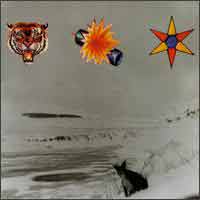

 Mehr ...
Mehr ...
|
"Wenn eine Gruppe mit drei ep´s zum bekanntesten
Geheimtip Englands wird, vermutet man natürlich eine hinterhältige
Vermarktungsstrategie. Doch weit gefehlt: The Beta Band hat sich den Ruhm
redlich verdient. Auf The Three EP´s rollen Gitarre, Bass und Schlagzeug
in Kornkreis-Formationen durch groovigen Psycho-Gitarren-Pop. Für
die abwechslungsreichen Arrangements greift das eigentlich akustische
Quartett auch mal auf etwas Elektronik zurück, und auch sonst ist
alles drin, was vier Spinnern halt so einfällt. Englische Exzentrik
in höchster Qualität, wie sie sonst nur Julian Cope produziert.“
(Rolling Stone. Formidabel)
|
|
“Buzzy Glasgow combo gather their complete works to
date - three highly-collectable limited edition EPs from last year. Seventy-eight
minutes in all.
People dig The Beta Band for several reasons. Among these are: they sound
bonkers; they sound single-mindedly joyful in their pursuit of the wooziest
grooves in the cosmos; they sound like they don't give a flying one. They
remind you of stuff but are also unique. Their packaging's nice too. Thank
God for a band on a major with the guts to plough their own furrow (and
a major label prepared to pay for it, come to that). Highlights? The let's-get-it-on-with-a-tambourine
intimacy of I Know, the lovely monastic Dr Baker, the super-laid-back lope
of idler's manifesto Dry The Rain, the stoned prowl of Push It Out and the
16-minute meander The Monolith. The landscape of their sound is littered
with bongos, lazy acoustic guitar, Jew's harp, bird song, hand claps and
dub bass. Weaving through it all, the multi-tracked, sleepy voice of Steve
Mason. So idiosyncratic and unprocessed is this music that people are moved
to pay £30 for copies of the original EPs. One day you know they'll
lock eyeballs with the times like, say, Pink Floyd did. Right now they're
working up a good groove banging on the gates of dawn.” (MOJO) |
|
| “The Beta Band have a habit of stumbling across gold
as they weave their ramshackle way round a tune. While Steve Mason's gruff
singing, resembling the mumbling of a barely conscious man, complements
the unpredictable brew. But in stubbornly avoiding the normal conventions
of songwriting they occasionally veer away from a tune altogether. This
results in epics like Monolith, which clocks in at just under 16 minutes
and sounds like aimless doodling along to BBC sound effects records. However
at their best (and most succinct), as on Dry The Rain and It's Over, their
ability to wrest a tune from the eclectic instruments and percussion is
akin to the best of the sonic invention of Beck.” (Q. 3/5) |
|
| Mojave 3: "Out Of Tune" (4AD, Okt. 1998) |
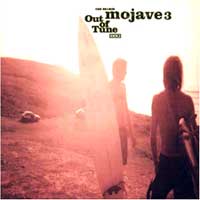 Englische Band mit sehr amerikanischem Sound, wie schon der Name vermuten
lässt. Am ehesten noch mit den wunderbaren Mazzy
Star vergleichbar!
Englische Band mit sehr amerikanischem Sound, wie schon der Name vermuten
lässt. Am ehesten noch mit den wunderbaren Mazzy
Star vergleichbar!

 Mehr ...
Mehr ...
|
"Es fällt jedes Jahr aufs neue schwer, wenn sich im September
die letzten Bademeister aus den Freibädern trollen und die ersten
Christstollen im Supermarkt unleugbar vom Herbst künden. Wie vorteilhaft,
wenn zur gleichen Zeit Alben auf den Plan treten, die mit diesem Umstand
zu versöhnen wissen und einem die Muße länger werdender
Abende schmackhaft machen können. Mit seiner besinnlichen Melodik,
warmen akustischen Sounds zu hintergründigen Keyboards, leisem Country-Flair
und verträumten Vocals macht sich der Zweitling des britischen Quintetts
zu einem ausgesprochen angenehmen Begleiter bei Laubrascheln und Nebelschwaden.
Ob in den volleren Klangfarben feiner Arrangements oder der spartanischen
Instrumentierung von "Yer Feet", das in seiner Einfachheit auf
allerkleinster Flamme köchelt und dabei nichts an Schönheit
verliert: in der ruhigen, sehnsuchtsvollen Melancholie von "Out Of
Tune" läßt sich höchst behaglich schwelgen."
(Jennifer Koegst / Intro)
|
|
|
"Dieses Album "Out Of Tune" ("verstimmt")
zu taufen, kann nur pure Koketterie sein. Der Nachfolger zum hochgelobten
95er Debüt des
britischen Quintetts ist fast bis an die Schmerzgrenze voller Harmonie
und Wohlklang. Songwriter und Sänger Neil Halstead plus Band kreierten
ein durch und durch ruhiges, folkig-poppiges Album, das gerade durch seine
Schlichtheit überzeugt. Die endlosen Weiten der Landschaft Cornwalls,
wo die Musik entstand, trugen sicherlich das Ihrige zur relaxten Atmosphäre
bei." (Audio)
|
|
| Dixie Chicks: "Wide Open Spaces" (Columbia, Nov. 1998) |
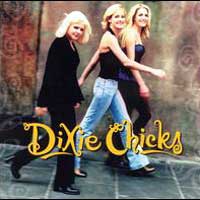 Countryplatten mit guter Musik machen und trotzdem millionenfach
verkaufen? Geht nicht? Geht doch! Einfach stark, diese Mädels!
Countryplatten mit guter Musik machen und trotzdem millionenfach
verkaufen? Geht nicht? Geht doch! Einfach stark, diese Mädels!

 Mehr ...
Mehr ...
When sisters Martie Seidel and Emily Erwin founded the Dixie Chicks in 1989, could they have possibly known the success that would someday be theirs? After three independent records and several lineup changes, the group was re-energized by new lead singer Natalie Maines and the support of a major label, and exploded onto the contemporary country scene with the release of Wide Open Spaces. As always, their strengths lie in their honey-sweet harmonies and superb musicianship, now topped off by the sassy power of Maines' lead vocals. Apparently, they know how to pick songs as well, with "I Can Love You Better," "Wide Open Spaces," and "There's Your Trouble" all breaking into the Top Ten and pushing album sales into the multi-platinum category. Wide Open Spaces is a wonderful blend of traditional elements such as banjo, fiddle, and steel guitar, and contemporary attitude, most notably a strong female perspective. As far as subject matter goes, they cover all the bases by tossing in a great honky tonk/bar/broken-heart song with "Tonight the Heartache's on Me," several touching ballads including "I'll Take Care of You," "Loving Arms," and "You Were Mine," and an in your face, unapologetic breakup anthem ("Let ?Er Rip"). When choosing tunes to cover, they tip their hat to some great, though perhaps surprising, women songwriters in Maria McKee and Bonnie Raitt with the last two tracks on the record. The charm and talent of the Dixie Chicks earned them well-deserved popularity across genre borders, and rightly so. Wide Open Spaces is a highly enjoyable listen.
(by Kelly McCartney, All Music Guide)
|
| Fink: "Loch in der Welt" (iXiXeS, 1998) |


 Mehr ...
Mehr ...
Das Album von 1998 - ursprünglich durch XXS Records veröffentlicht - erscheint jetzt erstmalig auf Vinyl! Neben dem Titeltrack Inklusive der Songs »Als einer einmal nicht kam«, »Meine Ecke«, »Neuer Anzug«, »Fisch im Maul«, »Sie wollen uns erzählen« und »Mann ohne Schmerzen«. Das frische Vinyl-Mastering hat Chris von Rautenkranz (Soundgarden) übernommen, das Vinyl kommt im klassischen schwarz.
|
| Lyle Lovett: "Step Inside This House" (Curb, 1998) |
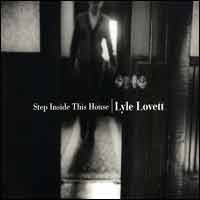 Selbst ein begnadeter Songschreiber vor dem Herren, huldigt der
Ex-Gatte von Julia Roberts (das konnte ich mir nun doch nicht verkneifen!)
bei diesem Projekt seinen großen Vorbildern aus Texas. Einige
dieser Songschreiber werden hier jeweils mit mehreren Liedern vorgestellt
und somit besonders "geadelt": Townes van Zandt,
Steven Fromholz und Walter Hyatt.
Selbst ein begnadeter Songschreiber vor dem Herren, huldigt der
Ex-Gatte von Julia Roberts (das konnte ich mir nun doch nicht verkneifen!)
bei diesem Projekt seinen großen Vorbildern aus Texas. Einige
dieser Songschreiber werden hier jeweils mit mehreren Liedern vorgestellt
und somit besonders "geadelt": Townes van Zandt,
Steven Fromholz und Walter Hyatt.
Insgesamt ein gelungenes Album mit einer Begleitband der Spitzenklasse:
Schlagzeuger Russ Kunkel (Jackson Browne, Jimmy Buffett),
Nashville's Top-Pianist Matt Rollings, Mandolinenmeister
Sam Bush, Dobrokönig Jerry Douglas, Studiogitarrenlegende
Dean Parks (Steely Dan, Little Feat, Joe Cocker, etc., Bluegrassgeiger
Stuart Duncan, Nashville's angesagtester Steeler Paul
Franklin, Kontrabassist Viktor Krauss und Bassgitarrist Lee
Sklar (der Mann mit dem langen Bart! Oft bei Jackson Browne (z.B.
auf "Running On Empty")
zu sehen und zu hören, leider auch Phil Collins: aber man muss
ja von was leben!).

 Mehr ...
Mehr ...
|
"Step Inside This House, in a way, is a perfect
follow-up to The Road to Ensenada, his straightest country album since
his debut, taking Lyle Lovett back to the very beginning, as he covers
his favorite songwriters. He consciously avoids such obvious influences
as Randy Newman and Jesse Winchester, choosing to concentrate almost solely
on Texan singer/songwriters, resulting in a minor revelation. Lovett's
place in Texas' progressive country tradition has always been evident,
and his good taste has never been in question, but this not only confirms
his strength as a performer, but also illustrates the origins of his clear,
wry narratives. He not only sheds light on songwriters known better for
their reputation than their actual recordings (Townes Van Zandt, Guy Clark,
Walter Hyatt, Michael Martin Murphey, Robert Earl Keen), yet he carries
a torch for obscure names like Eric Taylor, Vince Bell and Craig Calvert,
David Rodriquez, and Steve Fromholz, who has no less than four songs on
the album. For all the different writers, what's striking about Step Inside
This House is how all the songs seem to spring from the same worldview.
Few covers albums are as unified and Lovett's achievement is particularly
noteworthy since none of the songs are standards." (Stephen Thomas
Erlewine, All Music Guide)
|
|
| Beverley Martyn: "No Frills" (One World, 1998) |
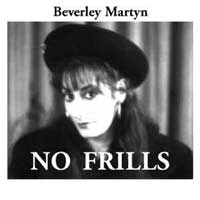 Die
Platte habe ich erst vor kurzem durch Zufall entdeckt. Sie war teuer
(über 20 Euro) und hatte eine lange Lieferzeit, aber ich bin
jetzt froh, das erste und einzige Soloalbum der Ex-Gesangspartnerin
und Ex-Ehefrau von John Martyn in Händen zu halten. Auch
wenn das Coverfoto nicht besonders toll ist: scheinbar stammt das
Bild aus einem Passfotoautomaten. Die
Platte habe ich erst vor kurzem durch Zufall entdeckt. Sie war teuer
(über 20 Euro) und hatte eine lange Lieferzeit, aber ich bin
jetzt froh, das erste und einzige Soloalbum der Ex-Gesangspartnerin
und Ex-Ehefrau von John Martyn in Händen zu halten. Auch
wenn das Coverfoto nicht besonders toll ist: scheinbar stammt das
Bild aus einem Passfotoautomaten.
Zu hören sind 11 eigene Lieder von Beverley, die pur mit ihrer
Stimme und Gitarre und ohne Overdubs aufgenommen wurden. Ich mag das
- vielleicht nur, weil eine Platte von Beverley Martyn ein solch seltenes
Juwel ist. Auf jeden Fall würde ich mir wünschen, das da
noch mal was kommt, denn ihre Lieder und ihre Stimme auf den beiden
gemeinsamen Alben von 1970 ("Stormbringer"
und "Road To Ruin") hatte
ich danach auf den Soloalben von John Martyn doch sehr vermisst ...
(08.01.2006) |
| Allison Moorer: "Alabama Song" (MCA, 1998) |
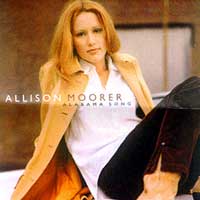 Natürlich ist diese Platte nicht mehr wirklich "frisch".
Aber ich habe sie gerade eben erst entdeckt, denn nach "Show",
dem wunderschönen Livealbum samt Konzert-DVD vom vergangenen
Jahr, habe ich jetzt auch angefangen, mich mit dem Back-Katalog von
Shelby Lynnes jüngerer Schwester
zu beschäftigen und habe mit diesem Debüt von 1998 eine
echte Entdeckung gemacht. Deutlich mehr Mainstream-Country als das
Livealbum, aber trotzdem(?) richtig gut. Und wenn man(n) das ganze
jetzt aus der zeitlichen Distanz noch beurteilt, muss hoch angerechnet
werden, dass Miss Moorer es trotz ihrer stimmlichen und optischen
Voraussetzungen geschafft hat, sich dem Nashville-Mainstream genug
zu entziehen, um inzwischen zu einer interessanten Künstlerin,
Sängerin und Songschreiberin, herangereift zu sein und nicht
zur nächsten Shania Twain zurechtgebogen zu werden.
Natürlich ist diese Platte nicht mehr wirklich "frisch".
Aber ich habe sie gerade eben erst entdeckt, denn nach "Show",
dem wunderschönen Livealbum samt Konzert-DVD vom vergangenen
Jahr, habe ich jetzt auch angefangen, mich mit dem Back-Katalog von
Shelby Lynnes jüngerer Schwester
zu beschäftigen und habe mit diesem Debüt von 1998 eine
echte Entdeckung gemacht. Deutlich mehr Mainstream-Country als das
Livealbum, aber trotzdem(?) richtig gut. Und wenn man(n) das ganze
jetzt aus der zeitlichen Distanz noch beurteilt, muss hoch angerechnet
werden, dass Miss Moorer es trotz ihrer stimmlichen und optischen
Voraussetzungen geschafft hat, sich dem Nashville-Mainstream genug
zu entziehen, um inzwischen zu einer interessanten Künstlerin,
Sängerin und Songschreiberin, herangereift zu sein und nicht
zur nächsten Shania Twain zurechtgebogen zu werden.
Der Titelsong erinnert zwar ein wenig an "Tupelo
Honey", was aber natürlich eine erstklassige Referenz
ist. Die einzige Coverversion "Tell Me Baby" stammt von
dem bei uns eher unbekannten texanischen Songschreiber Walter Hyatt
und ist in Allisons Version ein echtes Juwel!
(16.01.2004)

 Mehr ...
Mehr ...
|
"Newcomer im Country-Lager, die mit ihrem Beitrag zum "Horse
Whisperer" Soundtrack zum ersten Mal auf sich aufmerksam machte.
Sie geht zwar optisch in Richtung der gestylten Nashville-Gals Shania
Twain, Trisha Yearwood und LeAnn Rimes, die ja alle mittlerweile Popstars
geworden sind, kann sich aber noch ein gerüttelt Maß an Persönlichkeit
bewahren. Ihre Stimme ist natürlicher als die der durchgestylten
Pop-Püppchen, die Dead Reckonings und Buddy Miller haben mitgespielt
und Allison ist fast für das gesamte Songmaterial zuständig.
"Alabama Song" ist sicher beinahe Mainstream, aber irgendwie
hat dieses Debüt Seele und das macht es wertvoll."
(Glitterhouse)
|
|
|
Allison Moorer's debut album delicately balances and divides '90s country
aesthetics into two parts: one wants to stick pretty close to classic
Nashville structure and songwriting, while the other is acutely aware
of the rising pop saturation of the music. Fortunately, she sticks near
the former throughout most of this glowing, but somewhat derivative, album
-- at times, almost too near. Moorer is so intent on keeping herself and
Alabama Song grounded that they occasionally have trouble lifting off.
But her commitment and integrity eventually win (Moorer co-wrote ten of
Alabama Song's 11 tracks), giving the album the trad-country boost it
needed. Best is "A Soft Place to Fall" (which was originally
featured on the soundtrack to The Horse Whisperer), a bittersweet tale
of love's securities and insecurities that shows off both Moorer's husky,
vibrant voice and her sharp way around a tune.
(by Michael Gallucci, All
Music Guide)
|
|
| Druha Trava & Peter Rowan: "New Freedom Bell" (Compass, 1998/2001) |
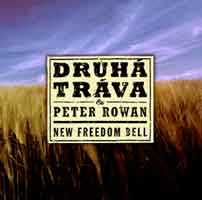 Peter Rowan, Rocklegende (Earth
Opera und Seatrain) und
Bluegrasslegende (Bill Monroe, Old
And In The Way) als Gaststar bei der tschechischen Band Druha
Trava. Nichts für Puristen (E-Gitarren!), aber doch sehr schön.
Mit zwei Dylan-Covern, allerdings nicht den "üblichen
Verdächtigen", sondern vom aktuellen Werk "Time
Out Of Mind"!
Peter Rowan, Rocklegende (Earth
Opera und Seatrain) und
Bluegrasslegende (Bill Monroe, Old
And In The Way) als Gaststar bei der tschechischen Band Druha
Trava. Nichts für Puristen (E-Gitarren!), aber doch sehr schön.
Mit zwei Dylan-Covern, allerdings nicht den "üblichen
Verdächtigen", sondern vom aktuellen Werk "Time
Out Of Mind"!

 Mehr ...
Mehr ...
|
"Peter Rowan hatte in meinem persönlichen
Bluegrass-Pantheon schon immer einen Ehrenplatz und so kommt es auch nicht
von ungefähr, daß ich diese Zusammenarbeit mit dem tschechischen
Quintett Druhá Tráva (Second Grass) ganz vorzüglich
finde. Zwar besteht das Fundament hier aus Bluegrass, aber doch geht diese
Kollaboration bei vielen Songs weit über die Genre-Grenzen hinaus.
Da wird mal ein Song in tschechisch gesungen (funktioniert), Rowan revitalisiert
erfolgreich zwei seiner besten Songs („Moonlight Midnight“ und
„Dust Bowl Children“), dazu mehr oder weniger wagemutig gewählte
Coverversionen: „Dublin Blues“ von Guy Clark, „New Freedom
Bell“ (Country Gentlemen), „Burning Ground“ (Van Morrison)
und zwei Songs vom letzten Dylan-Album „Time Out Of Mind“. „Cold
Iron Bound“ ist dabei fast 10 Minuten köchelnde Intensität
mit E-Gitarren und Drums. Und von Bluegrass ist da nicht mehr viel zu
hören.
Absolute Pluspunkte sind weiterhin die erstklassige, und hier sehr wandlungsfähige
Stimme von Peter Rowan sowie die ungeheure Spielfreude von Druhá
Tráva, allesamt Multi-instrumentalisten mit gründlicher musikalischer
Ausbildung zwischen Jazz, traditionellen Spielarten und klassischer Musik.
Vielleicht funktioniert das hier so gut, weil die Burschen einen anderen
kulturellen Hintergrund haben, als die Herren Bush, Douglas, Atamaniuk
und O´Brien (die sicher auch ihre Meriten haben)?"(Glitterhouse)
|
|
| Wagon: "Anniversary" (Glitterhouse, 1997/1998) |
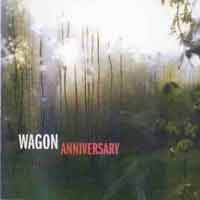 Mal wieder eine zufällige Entdeckung aus dem 2nd-Hand-Laden
(danke dafür an Bernd vom Duisburger "Far Out"!).
Obwohl es sich um eine Glitterhouse-Kapelle handelt, sind sie bisher
komplett an mir vorbeigegangen. Dies ist ihr zweites Album nach
einem mit Lloyd Maines (guter Mann! Papa der sehr mutigen
Dixie Chicks-Sängerin Natalie Maines, die z.Z. wegen ihrer
George Bush-Kritik die volle Breitseite an Schmähung in der
Heimat abbekommt) in Austin aufgenommenen Debüt. Von den Glitterhäuslern
gibt's auch noch einen Nachfolger vom Jahr 2000, den ich (noch)
nicht kenne. Ihre schlichte Homepage
kündigt mit letzter Aktualisierung vom September 2002 die Produktion
eines Nachfolgers an, der aber noch nicht fertig zu sein scheint.
Mal wieder eine zufällige Entdeckung aus dem 2nd-Hand-Laden
(danke dafür an Bernd vom Duisburger "Far Out"!).
Obwohl es sich um eine Glitterhouse-Kapelle handelt, sind sie bisher
komplett an mir vorbeigegangen. Dies ist ihr zweites Album nach
einem mit Lloyd Maines (guter Mann! Papa der sehr mutigen
Dixie Chicks-Sängerin Natalie Maines, die z.Z. wegen ihrer
George Bush-Kritik die volle Breitseite an Schmähung in der
Heimat abbekommt) in Austin aufgenommenen Debüt. Von den Glitterhäuslern
gibt's auch noch einen Nachfolger vom Jahr 2000, den ich (noch)
nicht kenne. Ihre schlichte Homepage
kündigt mit letzter Aktualisierung vom September 2002 die Produktion
eines Nachfolgers an, der aber noch nicht fertig zu sein scheint.
Die Musik? Schöner Folk- bzw. Countryrock, dessen zweistimmiger
Leadgesang ein bischen an die Jayhawks in ihren besten Momenten
von "Hollywood Townhall"
erinnert, aber keine Kopie, sondern eher gemeinsame Wurzeln. Die
Instrumentierung ist eine gelungene Mischung aus Rock (E-Gitarren,
Bass, Drums) und Country/Bluegrass (diverse Steelgitarren, viel
Geige (Gott sei dank ohne Irishpub-Einschlag), Banjo, Mandoline),
wobei sogar Platz für ein Flügelhorn ist (für alle
Ignoranten: das ist eine Trompete in etwas tieferer Stimmung).
(06.04.2003)

 Mehr ...
Mehr ...
|
„Anniversary" wurde in einer 200 Jahre alten
Scheune aufgenommen. Mit geliehenen, analogen Bandmaschinen, in ein paar
Wochen. Man hört es ihr an - und doch wieder nicht. Man hört
die harmonische Entspanntheit, den Langmut, das atmosphärische Gleichgewicht.
Man hört allerdings keinerlei Qualitätsunterschiede zu teuren
Produktionen.
Viele befreundete Musiker halfen, den Zweitling "Anniversary"
einzuspielen. John Higgins spielte Dobro, Lap-Steel und Pedal-Steel, Karen
Schulz Cello, Steve Rauner (ehemaliger Wagon-Teilzeitler und mittlerweile
festes Mitglied bei den nicht minder formidablen Nadine) steuerte diverse
alte Orgeln und sonstige Tasteninstrumente bei, John Horton spielte zusätzliche
Gitarren ein und der am Jazz geschulte Chris Kase bläst hier ein
stoisches Flügelhorn, das weit mehr als bloße Untermalung ist.
Großartiges Ensemblespiel, das. Völlig unverkrampft, völlig
natürlich und together.
Elf Titel nahm man auf (gemixt wurde von Ben und Sean Haney im G-Studio,
Brooklyn, New York). Schöne, sanft perlende Songs. Weich fließend,
im besten Sinne swingend, eingängig, melodiös. Und doch lugt
stets ein Körnchen Hintersinn, eine Ahnung von dunklem Abgrund durch
die prachtvollen Harmoniegesänge, stets steht da etwas Unausgesprochenes,
latent Bedrohliches im Raum. Sehnsüchtiger, smoother Gesang, verzaubernd.
Großartiges Songmaterial, auch.
|
|
| „... Songs zum Steinerweichen schön und Harmoniegesänge
von jener bezaubernden Unschärfe, die jede Melodie garantiert kitschfrei
hält. `Music From
Big Pink´ für die Neunziger! Oder das schönste Country-Album
seit `Hollywood
Town Hall´ der Jayhawks." (Kulturnews) |
|
| "Ein großes Album, voller entrückt-schillernder
Momente, geträumt in Desert-Highway Motel-Betten in allerschönstem
Breitwandformat." (Indigo Notes) |
|
| "Das zweite Wagon-Album ist denn auch eine im besten
Sinne amerikanische Angelegenheit: Songs wie `Dead Man´s Shoes´
dampfen fröhlich durch die Mountains, Canyons und Valleys der alternativen
US-Roots, halten mal an diesem Vorortbahnhof, mal an jenem `Corner Of Town´,
haben das Byrds-Spätwerk ebenso im Tender wie das der Walkabouts. Und
ausgesuchtes Begleitpersonal an Orgel, Flügelhorn, Mandoline, Cello,
Lap- und Pedal Steel-Gitarre, das die elf eingängigen Songs zwischen
warmer Melancholie, bittersüßer Harmonie, beschaulicher Nähe
und großer Sehnsucht mit viel Kompetenz uns spielerischem Einfühlungsvermögen
geschmackvoll schmückt und füllt. Eine entspannte, runde Freude."
(WOM Journal) |
|
| „Völlig auf der Höhe der Zeit“. (Rolling
Stone) |
|
| „Schon jetzt: Das Album des Jahres!“ (Kulturspiegel) |
|
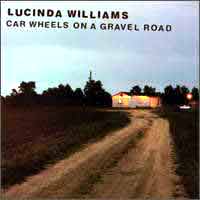 Ein Meisterwerk! Zur Zeit meine absolute Favoritin unter den Songschreiberinnen!
Ein Meisterwerk! Zur Zeit meine absolute Favoritin unter den Songschreiberinnen!
 Mehr ...
Mehr ...
 weitere Highlights Jahres (die Top 8)
weitere Highlights Jahres (die Top 8) "Nur" eine Outakes-Kompilation und doch besser als vieles,
wofür andere Künstler lange stricken müssten bzw.
das gar nicht hinkriegen würden!
"Nur" eine Outakes-Kompilation und doch besser als vieles,
wofür andere Künstler lange stricken müssten bzw.
das gar nicht hinkriegen würden!
 Mehr ...
Mehr ...
 Ein
tolles Projekt: gemeinsam nahmen sich Billy Bragg und Wilco bisher
nicht bekannte Texte von Woody Guthrie vor und schrieben dazu
neue Musik. Die ganze Sache hat den Beteiligten wohl soviel Spaß gemacht,
dass zwei Jahre später noch man ein kompletter Nachschlag erschien!
Ein
tolles Projekt: gemeinsam nahmen sich Billy Bragg und Wilco bisher
nicht bekannte Texte von Woody Guthrie vor und schrieben dazu
neue Musik. Die ganze Sache hat den Beteiligten wohl soviel Spaß gemacht,
dass zwei Jahre später noch man ein kompletter Nachschlag erschien!
 Son Volt, die Band um den Sänger/Gitarristen und Songschreiber
Jay Farrar ist die andere Band neben Jeff Tweedy's Wilco
in der Nachfolge von Uncle Tupelo.
Mich nervt dieser Streit, ob Son Volt oder Wilco die besseren Uncle
Tupelo sind. Dazu nur soviel: beiden Bands merkt man die gemeinsame
Vergangenheit mehrerer ihrer Mitspieler an. Beide Bands haben deshalb
durchaus Ähnlichkeiten im Sound, aber eben auch sehr viel individuelle
Unterschiede. Aber beide Bands sind klasse. Man kann das vielleicht
mit den Produktionen der beiden Ex-Köpfen von meiner Lieblingsband
"The Go-Betweens"
vergleichen: Nur gab's da keinen Fanstreit um den "richtigen"
Erben. Nur eine kurze Theorie von mit dazu: Jay Farrar ist eher Robert
Forster und Jeff Tweedy eher Grant McLennan. Aber wer ist
jetzt Lennon und wer McCartney? Fragen über Fragen!
Son Volt, die Band um den Sänger/Gitarristen und Songschreiber
Jay Farrar ist die andere Band neben Jeff Tweedy's Wilco
in der Nachfolge von Uncle Tupelo.
Mich nervt dieser Streit, ob Son Volt oder Wilco die besseren Uncle
Tupelo sind. Dazu nur soviel: beiden Bands merkt man die gemeinsame
Vergangenheit mehrerer ihrer Mitspieler an. Beide Bands haben deshalb
durchaus Ähnlichkeiten im Sound, aber eben auch sehr viel individuelle
Unterschiede. Aber beide Bands sind klasse. Man kann das vielleicht
mit den Produktionen der beiden Ex-Köpfen von meiner Lieblingsband
"The Go-Betweens"
vergleichen: Nur gab's da keinen Fanstreit um den "richtigen"
Erben. Nur eine kurze Theorie von mit dazu: Jay Farrar ist eher Robert
Forster und Jeff Tweedy eher Grant McLennan. Aber wer ist
jetzt Lennon und wer McCartney? Fragen über Fragen!
 Mehr ...
Mehr ...
 Eine späte Entdeckung! Der Mann ist schon seit den 60ern/70ern
dabei - und ich hatte noch nie was von ihm gehört! Eine tolle
Mischung aus Tim Buckley (diese
akustische 12saitige!) und Curtis
Mayfield (diese Stimme) bzw. aus Folk und Soul. Beim Titelsong
ist sogar Labelkollege und Saxofonmeister Pharoah
Sanders zu hören!
Eine späte Entdeckung! Der Mann ist schon seit den 60ern/70ern
dabei - und ich hatte noch nie was von ihm gehört! Eine tolle
Mischung aus Tim Buckley (diese
akustische 12saitige!) und Curtis
Mayfield (diese Stimme) bzw. aus Folk und Soul. Beim Titelsong
ist sogar Labelkollege und Saxofonmeister Pharoah
Sanders zu hören!
 Mehr ...
Mehr ...
 Wunderbar
schaurig-schöner Schrammel-Singer-Songwriter-Folk-Pop-Rock. Es
bleibt allerdings unklar, wie eine Plattenfirma wie Atlantic so etwas
unkommerzielles verkaufen will.
Wunderbar
schaurig-schöner Schrammel-Singer-Songwriter-Folk-Pop-Rock. Es
bleibt allerdings unklar, wie eine Plattenfirma wie Atlantic so etwas
unkommerzielles verkaufen will.  Geniales
Trio aus Norwegen, das alles in dem Bermudadreieck von Heavy Metal,
Freejazz und Countrymusik drauf hat. Und die beste 70er-Jahre-Mucke
in unseren Tagen spielt. In einem wahrlich unbändigen Schaffensdrang
wurden für diese Doppel-CD 14 neue Songs eingespielt, incl. dem
Ohrwurm "Vortex Surfer".
Geniales
Trio aus Norwegen, das alles in dem Bermudadreieck von Heavy Metal,
Freejazz und Countrymusik drauf hat. Und die beste 70er-Jahre-Mucke
in unseren Tagen spielt. In einem wahrlich unbändigen Schaffensdrang
wurden für diese Doppel-CD 14 neue Songs eingespielt, incl. dem
Ohrwurm "Vortex Surfer". Fairport Convention: "Liege and Lief" (1969) |
Fotheringay (1970) |
"Sandy" (1972) |
Fairport Convention: "Rising For The Moon" (1975)]
Fairport Convention: "Liege and Lief" (1969) |
Fotheringay (1970) |
"Sandy" (1972) |
Fairport Convention: "Rising For The Moon" (1975)]
 Mehr ...
Mehr ...
 Der
Top-Mandolinist der Szene, Ex-Bandleader von "New
Grass Revival" und Emmylou's "Nash
Ramblers" bietet auf seiner neuen Sugar Hill CD selbstredend
swingende Bluegrass Instrumentals mit unwiderstehlichen Virtuosen
am Arbeitsgerät (Schlagzeuger Larry Atamanuik, die Banjospieler
J.D. Crowe und Bela Fleck, Dobromeister Jerry Douglas,
die Kontrabassisten Victor Krauss und Roy Huskey Jr.,
Bassgitarrist John Cowan, Saitenmulti Darrell Scott).
Auf jedes Instrumental folgt ein hinreißender Vokalsong (tolle
Stimme) wie „Face Tomorrow“, „Hold On“ von Traffic
(!) oder „Song For Roy“, welches dem kürzlich verstorbenen
(und hier noch mitmusizierenden) Akustik-Bassisten Roy Huskey Jr.
gewidmet ist. Da war sich auch Emmylou Harris nicht für
Gesangseinlagen zu schade. Schön unspektakulär und zeitlos
produziert noch dazu. Grassfans werden begeistert sein.
Der
Top-Mandolinist der Szene, Ex-Bandleader von "New
Grass Revival" und Emmylou's "Nash
Ramblers" bietet auf seiner neuen Sugar Hill CD selbstredend
swingende Bluegrass Instrumentals mit unwiderstehlichen Virtuosen
am Arbeitsgerät (Schlagzeuger Larry Atamanuik, die Banjospieler
J.D. Crowe und Bela Fleck, Dobromeister Jerry Douglas,
die Kontrabassisten Victor Krauss und Roy Huskey Jr.,
Bassgitarrist John Cowan, Saitenmulti Darrell Scott).
Auf jedes Instrumental folgt ein hinreißender Vokalsong (tolle
Stimme) wie „Face Tomorrow“, „Hold On“ von Traffic
(!) oder „Song For Roy“, welches dem kürzlich verstorbenen
(und hier noch mitmusizierenden) Akustik-Bassisten Roy Huskey Jr.
gewidmet ist. Da war sich auch Emmylou Harris nicht für
Gesangseinlagen zu schade. Schön unspektakulär und zeitlos
produziert noch dazu. Grassfans werden begeistert sein. weitere Highlights ...
weitere Highlights ...  Ein Wahnsinns-Trio: Jazz-Zauberer Frisell zusammen mit dem Bassisten
Victor Krauss (spielt in Nashville alles von Bluegrass, Country
bis Jazz), sowie meinem Lieblingsdrummer Jim Keltner.
Ein Wahnsinns-Trio: Jazz-Zauberer Frisell zusammen mit dem Bassisten
Victor Krauss (spielt in Nashville alles von Bluegrass, Country
bis Jazz), sowie meinem Lieblingsdrummer Jim Keltner.
 Mehr ...
Mehr ...
 Duo-Liveaufnahmen von 1992 des Grateful Dead-Gitarristen und des aus
seiner Zusammenarbeit mit David Grisman und Lou
Reed bekannten Kontrabassisten. Die Keimzelle der Band Ratdog!
Duo-Liveaufnahmen von 1992 des Grateful Dead-Gitarristen und des aus
seiner Zusammenarbeit mit David Grisman und Lou
Reed bekannten Kontrabassisten. Die Keimzelle der Band Ratdog!
 Mehr ...
Mehr ...
 Bereits am 07.09.1996 mitgeschnittener Clubgig des Meisters mit großer Besetzung.
Bereits am 07.09.1996 mitgeschnittener Clubgig des Meisters mit großer Besetzung.
 Mehr ...
Mehr ...
 Irgendwann 1997 nahmen der Toningenieur Phill Brown und der
ehemalige Talk Talk Sänger Mark Hollis dieses Album auf,
durchweg mit akustischen Instrumenten. Obwohl die Aufnahmen mit nur
zwei Raummikrophonen gemacht worden sein sollen, dauerte es doch Monate
(und verschlang dabei reichlich Geld) bis man diese beiden Mikros
optimal positioniert hatte. Anfang `98 erschien das Album erstmals,
bekam allerorten richtig viel erstklassige Presse, jeder outete sich
als Talk Talk Fan (oder zumindest der letzten beiden Alben) und das
Album stieg damals sogar relativ hoch in den deutschen LP-Charts ein.
Was einen doch zum Wundern bringt, wenn man dieses sperrige Meisterwerk
erstmals hört.
Irgendwann 1997 nahmen der Toningenieur Phill Brown und der
ehemalige Talk Talk Sänger Mark Hollis dieses Album auf,
durchweg mit akustischen Instrumenten. Obwohl die Aufnahmen mit nur
zwei Raummikrophonen gemacht worden sein sollen, dauerte es doch Monate
(und verschlang dabei reichlich Geld) bis man diese beiden Mikros
optimal positioniert hatte. Anfang `98 erschien das Album erstmals,
bekam allerorten richtig viel erstklassige Presse, jeder outete sich
als Talk Talk Fan (oder zumindest der letzten beiden Alben) und das
Album stieg damals sogar relativ hoch in den deutschen LP-Charts ein.
Was einen doch zum Wundern bringt, wenn man dieses sperrige Meisterwerk
erstmals hört.
 Mehr ...
Mehr ...

 Mehr ...
Mehr ...
 Dass sich das Solodebüt des ehemaligen Chefs vom "The
House Of Love" nicht grundsätzlich von einer Platte
seiner alten Band unterscheidet, hat sicherlich damit zu tun, dass
er ja auch da schon der "Chef" war. Angeblich ist er ein
schwieriger Mensch, was ich seit dem Konzert der wiedervereinigten
Band auf dem Haldern Open-Air 2005 gut nachvollziehen kann.
Ich sag nur: Van Morrison!.
Dass sich das Solodebüt des ehemaligen Chefs vom "The
House Of Love" nicht grundsätzlich von einer Platte
seiner alten Band unterscheidet, hat sicherlich damit zu tun, dass
er ja auch da schon der "Chef" war. Angeblich ist er ein
schwieriger Mensch, was ich seit dem Konzert der wiedervereinigten
Band auf dem Haldern Open-Air 2005 gut nachvollziehen kann.
Ich sag nur: Van Morrison!. Mehr ...
Mehr ...
 Singende
Songschreiberinnen der Extraklasse mit der Homebase Nashville gibt's
ja inzwischen eine ganze Reihe. Bei den Herren ragt für mich
im Moment ganz klar Jim Lauderdale heraus, Autor von einem meiner
Lieblingslieder Nashville's aus jüngster Zeit: "What Do
You Say To That", das George Strait zu Hitehren brachte
und sich jetzt auch im Waiting For Louise-Repertoire
befindet.
Singende
Songschreiberinnen der Extraklasse mit der Homebase Nashville gibt's
ja inzwischen eine ganze Reihe. Bei den Herren ragt für mich
im Moment ganz klar Jim Lauderdale heraus, Autor von einem meiner
Lieblingslieder Nashville's aus jüngster Zeit: "What Do
You Say To That", das George Strait zu Hitehren brachte
und sich jetzt auch im Waiting For Louise-Repertoire
befindet. Bereits das zweite Meisterwerk dieses phantastischen Duos (Gitarrist
David Rawlings ist mehr als ein einfacher Begleiter!), das klingt,
als käme es direkt aus den 30er Jahren, aber ohne die geringste
Spur von Nostalgie!
Bereits das zweite Meisterwerk dieses phantastischen Duos (Gitarrist
David Rawlings ist mehr als ein einfacher Begleiter!), das klingt,
als käme es direkt aus den 30er Jahren, aber ohne die geringste
Spur von Nostalgie!
 Mehr ...
Mehr ...

 Das zweite Album von der mittlerweile zum Oktett angewachsenen Band
aus Glasgow. Wunderschön melodisch-dichte Songs mit hingehaucht-zartem,
vielfach mehrstimmigen Gesang.
Das zweite Album von der mittlerweile zum Oktett angewachsenen Band
aus Glasgow. Wunderschön melodisch-dichte Songs mit hingehaucht-zartem,
vielfach mehrstimmigen Gesang.
 Mehr ...
Mehr ...
 Ein überraschend gutes, stimmiges und mutiges Album des Mannes aus New Orleans, der es nach furiosem
Karrierebeginn in den 60ern und 70ern mit funkig-schrägem Voodoo-Rock in den späteren Jahren
doch etwas gediegener angehen ließ. Das Album entstand teilweise in England mit erklärten Fans des
Meisters, zum Bleistift Paul Weller und Jason Pierce
von Spiritualized, die ihn offensichtlich zu Höchstleistungen
antreiben konnten ...
Ein überraschend gutes, stimmiges und mutiges Album des Mannes aus New Orleans, der es nach furiosem
Karrierebeginn in den 60ern und 70ern mit funkig-schrägem Voodoo-Rock in den späteren Jahren
doch etwas gediegener angehen ließ. Das Album entstand teilweise in England mit erklärten Fans des
Meisters, zum Bleistift Paul Weller und Jason Pierce
von Spiritualized, die ihn offensichtlich zu Höchstleistungen
antreiben konnten ...
 Mehr ...
Mehr ...
 Waren seine bisherigen Platten sehr spartanisch instrumentiert, so
hat er sich hier mit Kurt Wagners Nashville-Orchester Lambchop
zusammengetan.
Waren seine bisherigen Platten sehr spartanisch instrumentiert, so
hat er sich hier mit Kurt Wagners Nashville-Orchester Lambchop
zusammengetan. Beeindruckend. Klassischer amerikanischer 60er-Rock trifft auf Spacegitarren
Pink Floyd´scher Schule. Als Gäste dabei Levon Helm
und Garth Hudson von The Band,
schließlich ist es von Kingston, dem Heimatort der Band, nach
Woodstock, wo Levon wohnt, nur ein Steinwurf. Der Albumtitel, der
stammt von einem Greil Marcus Text über die ersten The
Band-Alben.
Beeindruckend. Klassischer amerikanischer 60er-Rock trifft auf Spacegitarren
Pink Floyd´scher Schule. Als Gäste dabei Levon Helm
und Garth Hudson von The Band,
schließlich ist es von Kingston, dem Heimatort der Band, nach
Woodstock, wo Levon wohnt, nur ein Steinwurf. Der Albumtitel, der
stammt von einem Greil Marcus Text über die ersten The
Band-Alben.
 Mehr ...
Mehr ...

 Mehr ...
Mehr ...

 Mehr ...
Mehr ...
 Fit & Limo sind (waren?) ein Duo aus Nürnberg, die
schon "Freakfolk" gemacht hat, als es so etwas noch gar
nicht gab - auf jeden Fall hieß es in den 90ern (noch) nicht
so. Aber eigentlich gibt es so was schon viel länger: denkt doch
mal an die wunderbare Incredible
Sring Band aus den späten 60ern, von denen die beiden ja
schon vier Lieder auf der 7"-EP "This Moment" gecovert
haben. Oder an unser heimisches Duo Witthüser
& Westrupp aus den 70ern.
Fit & Limo sind (waren?) ein Duo aus Nürnberg, die
schon "Freakfolk" gemacht hat, als es so etwas noch gar
nicht gab - auf jeden Fall hieß es in den 90ern (noch) nicht
so. Aber eigentlich gibt es so was schon viel länger: denkt doch
mal an die wunderbare Incredible
Sring Band aus den späten 60ern, von denen die beiden ja
schon vier Lieder auf der 7"-EP "This Moment" gecovert
haben. Oder an unser heimisches Duo Witthüser
& Westrupp aus den 70ern. Mehr ...
Mehr ...

 Mehr ...
Mehr ...
 Englische Band mit sehr amerikanischem Sound, wie schon der Name vermuten
lässt. Am ehesten noch mit den wunderbaren Mazzy
Star vergleichbar!
Englische Band mit sehr amerikanischem Sound, wie schon der Name vermuten
lässt. Am ehesten noch mit den wunderbaren Mazzy
Star vergleichbar!
 Mehr ...
Mehr ...
 Countryplatten mit guter Musik machen und trotzdem millionenfach
verkaufen? Geht nicht? Geht doch! Einfach stark, diese Mädels!
Countryplatten mit guter Musik machen und trotzdem millionenfach
verkaufen? Geht nicht? Geht doch! Einfach stark, diese Mädels!
 Mehr ...
Mehr ...

 Mehr ...
Mehr ...
 Selbst ein begnadeter Songschreiber vor dem Herren, huldigt der
Ex-Gatte von Julia Roberts (das konnte ich mir nun doch nicht verkneifen!)
bei diesem Projekt seinen großen Vorbildern aus Texas. Einige
dieser Songschreiber werden hier jeweils mit mehreren Liedern vorgestellt
und somit besonders "geadelt": Townes van Zandt,
Steven Fromholz und Walter Hyatt.
Selbst ein begnadeter Songschreiber vor dem Herren, huldigt der
Ex-Gatte von Julia Roberts (das konnte ich mir nun doch nicht verkneifen!)
bei diesem Projekt seinen großen Vorbildern aus Texas. Einige
dieser Songschreiber werden hier jeweils mit mehreren Liedern vorgestellt
und somit besonders "geadelt": Townes van Zandt,
Steven Fromholz und Walter Hyatt. Mehr ...
Mehr ...
 Die
Platte habe ich erst vor kurzem durch Zufall entdeckt. Sie war teuer
(über 20 Euro) und hatte eine lange Lieferzeit, aber ich bin
jetzt froh, das erste und einzige Soloalbum der Ex-Gesangspartnerin
und Ex-Ehefrau von John Martyn in Händen zu halten. Auch
wenn das Coverfoto nicht besonders toll ist: scheinbar stammt das
Bild aus einem Passfotoautomaten.
Die
Platte habe ich erst vor kurzem durch Zufall entdeckt. Sie war teuer
(über 20 Euro) und hatte eine lange Lieferzeit, aber ich bin
jetzt froh, das erste und einzige Soloalbum der Ex-Gesangspartnerin
und Ex-Ehefrau von John Martyn in Händen zu halten. Auch
wenn das Coverfoto nicht besonders toll ist: scheinbar stammt das
Bild aus einem Passfotoautomaten.  Natürlich ist diese Platte nicht mehr wirklich "frisch".
Aber ich habe sie gerade eben erst entdeckt, denn nach "Show",
dem wunderschönen Livealbum samt Konzert-DVD vom vergangenen
Jahr, habe ich jetzt auch angefangen, mich mit dem Back-Katalog von
Shelby Lynnes jüngerer Schwester
zu beschäftigen und habe mit diesem Debüt von 1998 eine
echte Entdeckung gemacht. Deutlich mehr Mainstream-Country als das
Livealbum, aber trotzdem(?) richtig gut. Und wenn man(n) das ganze
jetzt aus der zeitlichen Distanz noch beurteilt, muss hoch angerechnet
werden, dass Miss Moorer es trotz ihrer stimmlichen und optischen
Voraussetzungen geschafft hat, sich dem Nashville-Mainstream genug
zu entziehen, um inzwischen zu einer interessanten Künstlerin,
Sängerin und Songschreiberin, herangereift zu sein und nicht
zur nächsten Shania Twain zurechtgebogen zu werden.
Natürlich ist diese Platte nicht mehr wirklich "frisch".
Aber ich habe sie gerade eben erst entdeckt, denn nach "Show",
dem wunderschönen Livealbum samt Konzert-DVD vom vergangenen
Jahr, habe ich jetzt auch angefangen, mich mit dem Back-Katalog von
Shelby Lynnes jüngerer Schwester
zu beschäftigen und habe mit diesem Debüt von 1998 eine
echte Entdeckung gemacht. Deutlich mehr Mainstream-Country als das
Livealbum, aber trotzdem(?) richtig gut. Und wenn man(n) das ganze
jetzt aus der zeitlichen Distanz noch beurteilt, muss hoch angerechnet
werden, dass Miss Moorer es trotz ihrer stimmlichen und optischen
Voraussetzungen geschafft hat, sich dem Nashville-Mainstream genug
zu entziehen, um inzwischen zu einer interessanten Künstlerin,
Sängerin und Songschreiberin, herangereift zu sein und nicht
zur nächsten Shania Twain zurechtgebogen zu werden. Mehr ...
Mehr ...
 Peter Rowan, Rocklegende (Earth
Opera und Seatrain) und
Bluegrasslegende (Bill Monroe, Old
And In The Way) als Gaststar bei der tschechischen Band Druha
Trava. Nichts für Puristen (E-Gitarren!), aber doch sehr schön.
Mit zwei Dylan-Covern, allerdings nicht den "üblichen
Verdächtigen", sondern vom aktuellen Werk "Time
Out Of Mind"!
Peter Rowan, Rocklegende (Earth
Opera und Seatrain) und
Bluegrasslegende (Bill Monroe, Old
And In The Way) als Gaststar bei der tschechischen Band Druha
Trava. Nichts für Puristen (E-Gitarren!), aber doch sehr schön.
Mit zwei Dylan-Covern, allerdings nicht den "üblichen
Verdächtigen", sondern vom aktuellen Werk "Time
Out Of Mind"!
 Mehr ...
Mehr ...
 Mal wieder eine zufällige Entdeckung aus dem 2nd-Hand-Laden
(danke dafür an Bernd vom Duisburger "Far Out"!).
Obwohl es sich um eine Glitterhouse-Kapelle handelt, sind sie bisher
komplett an mir vorbeigegangen. Dies ist ihr zweites Album nach
einem mit Lloyd Maines (guter Mann! Papa der sehr mutigen
Dixie Chicks-Sängerin Natalie Maines, die z.Z. wegen ihrer
George Bush-Kritik die volle Breitseite an Schmähung in der
Heimat abbekommt) in Austin aufgenommenen Debüt. Von den Glitterhäuslern
gibt's auch noch einen Nachfolger vom Jahr 2000, den ich (noch)
nicht kenne. Ihre schlichte Homepage
kündigt mit letzter Aktualisierung vom September 2002 die Produktion
eines Nachfolgers an, der aber noch nicht fertig zu sein scheint.
Mal wieder eine zufällige Entdeckung aus dem 2nd-Hand-Laden
(danke dafür an Bernd vom Duisburger "Far Out"!).
Obwohl es sich um eine Glitterhouse-Kapelle handelt, sind sie bisher
komplett an mir vorbeigegangen. Dies ist ihr zweites Album nach
einem mit Lloyd Maines (guter Mann! Papa der sehr mutigen
Dixie Chicks-Sängerin Natalie Maines, die z.Z. wegen ihrer
George Bush-Kritik die volle Breitseite an Schmähung in der
Heimat abbekommt) in Austin aufgenommenen Debüt. Von den Glitterhäuslern
gibt's auch noch einen Nachfolger vom Jahr 2000, den ich (noch)
nicht kenne. Ihre schlichte Homepage
kündigt mit letzter Aktualisierung vom September 2002 die Produktion
eines Nachfolgers an, der aber noch nicht fertig zu sein scheint. Mehr ...
Mehr ...
 Das Album des Jahres
Das Album des Jahres
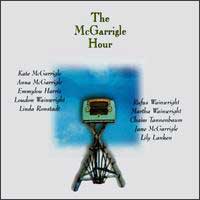

(2024-03-26)